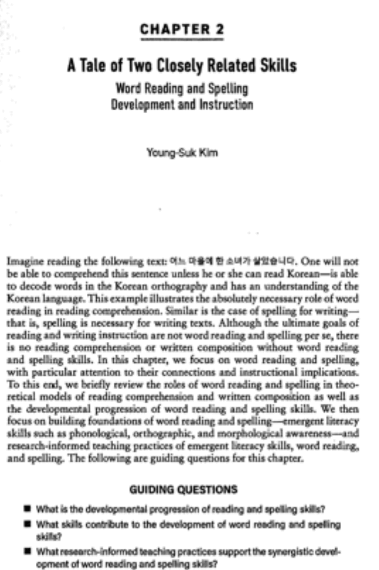SRSD Research: The Science of Writing
The research on Self-Regulated Strategy Development (SRSD) is extensive and unmatched, making it the most thoroughly studied, evidence-based writing process in the world. Numerous studies have consistently demonstrated its effectiveness in enhancing students’ writing skills across diverse educational settings. Based on decades of rigorous research about writing, SRSD stands as a powerful, proven method for improving writing instruction and student outcomes. Explore our comprehensive list of empirical studies to see how SRSD is transforming writing education.
Research-Based Writing Strategies
Research about writing consistently demonstrates that SRSD enhances reading and writing skills by providing explicit strategies that help students organize their thoughts and understand text structures. Improved writing skills through SRSD lead to better comprehension and analysis of texts, demonstrating a reciprocal relationship between reading and writing development. The following papers are our top recommendations to learn more about the research that goes into the creation and refinement of SRSD.
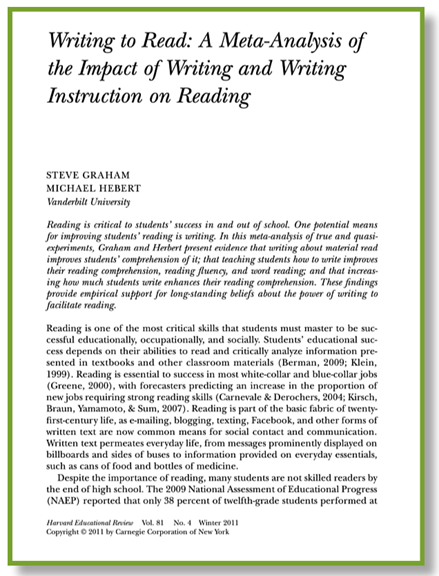
Writing to Read: A Meta-Analysis of the Impact of Writing and Writing Instruction on Reading
Graham & Hebert (2011)
The study “Writing to Read” by Steve Graham and Michael Hebert investigates the reciprocal relationship between writing and reading, emphasizing how writing can significantly enhance reading skills. This meta-analysis...
The study “Writing to Read” by Steve Graham and Michael Hebert investigates the reciprocal relationship between writing and reading, emphasizing how writing can significantly enhance reading skills. This meta-analysis synthesizes data from true and quasi-experiments, showing that writing about material students read improves their comprehension. Moreover, teaching students how to write enhances reading fluency, word recognition, and comprehension while simply increasing the amount students write boosts their reading performance. The study underscores the foundational role of writing in reading development, supporting theories that link these two literacy skills. By promoting reflection, organization, and critical engagement with the text, writing becomes a tool for expression and deeper comprehension and learning, thus offering educators evidence-based strategies to improve student literacy holistically.
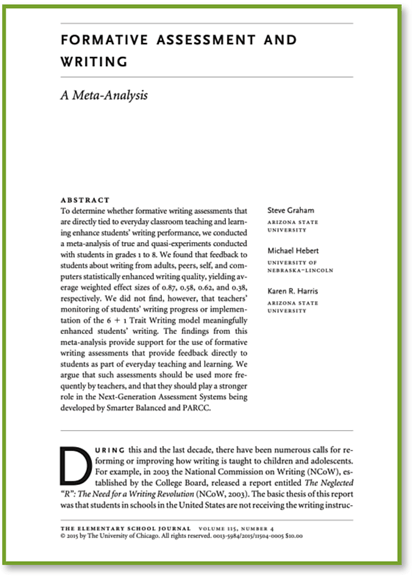
Formative Assessment and Writing: A Meta-Analysis
Graham, Hebert, and Harris (2015)
This meta-analysis delves into the power of formative writing assessments embedded in everyday classroom instruction, uncovering how different feedback sources—adults, peers, self, and even computers—impact students’...
This meta-analysis delves into the power of formative writing assessments embedded in everyday classroom instruction, uncovering how different feedback sources—adults, peers, self, and even computers—impact students’ writing skills. The findings reveal that adult feedback has the most substantial effect, with a weighted effect size of 0.87. In contrast, peer, self, and computer feedback significantly improve writing quality, with effect sizes of 0.58, 0.62, and 0.38, respectively. Interestingly, general teacher monitoring and the popular 6+1 Trait Writing model showed no meaningful impact on enhancing students’ writing. This research strongly advocates for using formative assessments that provide actionable feedback directly to students as a vital part of daily instruction. With implications for evolving assessment systems like Smarter Balanced and PARCC, this study makes a compelling case for prioritizing formative feedback in modern educational practice, aligning with calls for a “Writing Revolution” in schools.
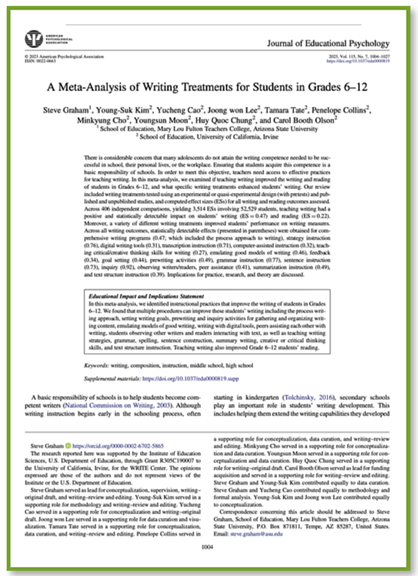
A Meta-Analysis of Writing Treatments for Students in Grades 6-12
Graham et al. (2023)
This meta-analysis by Steve Graham and colleagues examines the effectiveness of various writing interventions for students in grades 6–12, focusing on enhancing both writing and reading...
This meta-analysis by Steve Graham and colleagues examines the effectiveness of various writing interventions for students in grades 6–12, focusing on enhancing both writing and reading outcomes. An analysis of over 400 studies involving more than 52,000 students found that teaching writing significantly improved students’ writing. Specific interventions such as strategy instruction, feedback, goal setting, and the use of digital tools all positively impacted writing quality, with some approaches like inquiry-based activities and grammar instruction yielding especially high effect sizes. The findings underscore the importance of diverse, evidence-based writing practices that enhance students’ writing proficiency and strengthen their reading comprehension. This comprehensive review provides teachers and policymakers with essential insights into effective writing instruction, highlighting the potential for these strategies to support broader literacy development across secondary education.
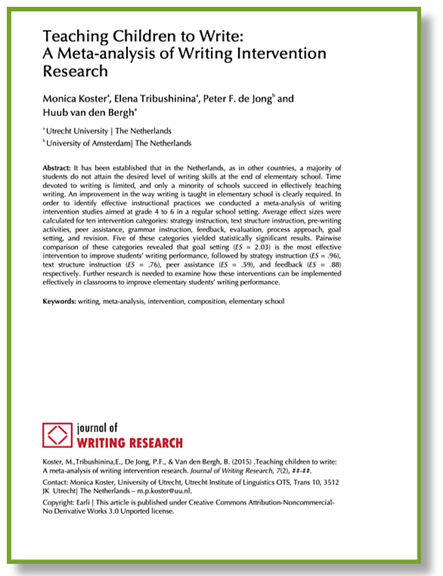
Teaching Children to Write: A Meta-analysis of Writing Intervention Research
Kastor et al. (2015)
This study looked at what works best to improve the writing skills of upper elementary students (grades 4-6) in regular classrooms, focusing on strategies that are most effective for...
This study looked at what works best to improve the writing skills of upper elementary students (grades 4-6) in regular classrooms, focusing on strategies that are most effective for helping students become better writers. It was found that setting clear writing goals was the most effective approach, significantly assisting students in improving their writing. Other helpful strategies included teaching students step-by-step writing strategies, showing them how to organize their ideas using text structures, giving specific feedback on their work, and having peers support each other during the writing process. The study also pointed out that many schools don’t spend enough time teaching writing, and teachers often don’t get enough training or suitable materials to help guide students in writing. The findings highlight the importance of using proven methods to teach writing and suggest that more research is needed to help teachers use these strategies in their classrooms effectively.
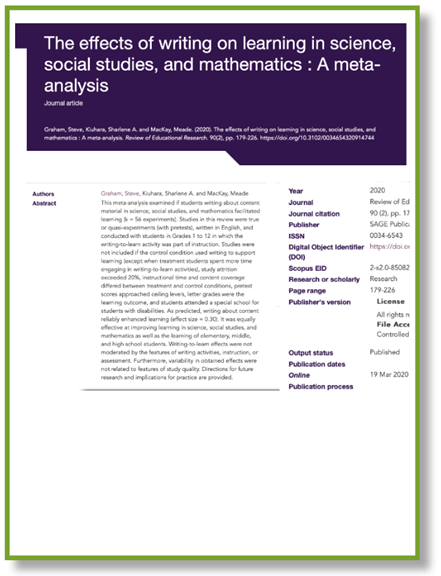
The Effects of Writing on Learning in Science, Social Studies, and Mathematics: A Meta-Analysis
Graham et al. (2020)
This meta-analysis explored whether having students write about what they are learning in science, social studies, and math helps improve their understanding. It reviewed 56 studies involving elementary, middle, and...
This meta-analysis explored whether having students write about what they are learning in science, social studies, and math helps improve their understanding. It reviewed 56 studies involving elementary, middle, and high school students where writing activities were part of instruction. The results showed that writing-to-learn strategies consistently enhanced learning, with similar benefits across all three subject areas and grade levels. The impact was not influenced by differences in the type of writing activities, instruction, or assessments used, nor by variations in study quality. The study highlights the value of incorporating writing-to-learn activities in classrooms to support student learning and offers insights for future research and teaching practices.
The Self-Regulated Strategy Development Instructional Model: Efficacious Theoretical Integration, Scaling Up, Challenges, and Future Research
Harris (2024)
In this landmark study, Karen Harris provides an in-depth examination of the Self-Regulated Strategy Development (SRSD) model, focusing on its theoretical underpinnings and evolution from its inception in the late...
In this landmark study, Karen Harris provides an in-depth examination of the Self-Regulated Strategy Development (SRSD) model, focusing on its theoretical underpinnings and evolution from its inception in the late 1970s to its present-day application. The study highlights how SRSD was developed to address complex learning needs, particularly in writing instruction, by integrating diverse theoretical approaches, including cognitive-behavioral, sociocultural, and developmental theories. Harris outlines how SRSD’s theoretical integration and triangulation foundation allows it to support students across affective, behavioral, and cognitive dimensions. This work demonstrates SRSD’s robust effectiveness, with research showing moderate to large effect sizes in writing and other complex learning tasks across multiple countries. Additionally, Harris addresses significant challenges in scaling up SRSD, such as paradigm conflicts within education and systemic barriers, emphasizing the need for future research to continue refining SRSD while enhancing its accessibility and impact in diverse educational contexts.
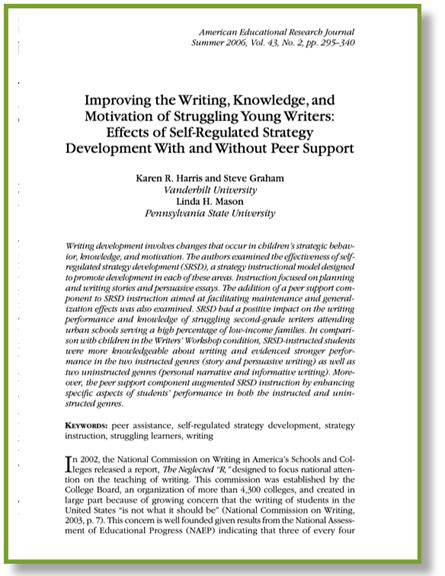
Improving the Writing, Knowledge, and Motivation of Struggling Young Writers:
Effects of Self-Regulated Strategy Development with and Without Peer Support
Harris and Graham (2006)
In their study, “Improving the Writing, Knowledge, and Motivation of Struggling Young Writers: Effects of Self-Regulated Strategy Development with and Without Peer Support,” Harris, Graham, and Mason examined the impact...
In their study, “Improving the Writing, Knowledge, and Motivation of Struggling Young Writers: Effects of Self-Regulated Strategy Development with and Without Peer Support,” Harris, Graham, and Mason examined the impact of Self-Regulated Strategy Development (SRSD) on second-grade students from urban, low-income schools who struggled with writing. The study focused on whether SRSD, with and without added peer support, could improve students’ writing skills, knowledge, and motivation. The SRSD approach, which emphasizes planning, self-regulation, and goal setting, was applied to teaching stories and persuasive writing. Results showed that students taught with SRSD outperformed those in the Writers’ Workshop control group in both taught and untaught genres. Including peer support further enhanced the student’s ability to generalize and retain the strategies across writing tasks. This research underscores SRSD’s effectiveness in bolstering writing skills, knowledge, and self-motivation, with peer assistance providing additional benefits in supporting strategy maintenance and adaptability.
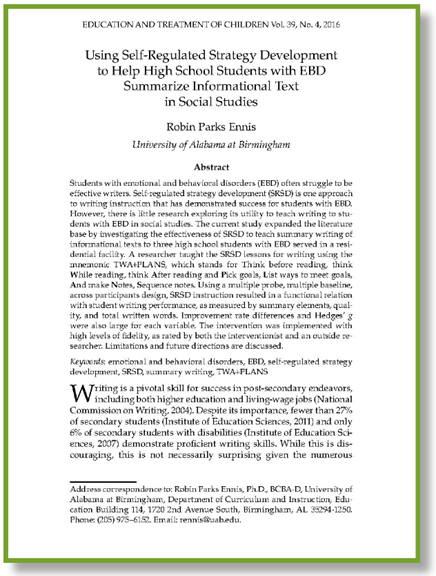
Using Self-Regulated Strategy Development to Help High School Students with EBD Summarize Informational Text in Social Studies
Ennis (2016)
Students with emotional and behavioral disorders (EBD) often face significant challenges with writing, which impacts their academic success. Self-Regulated Strategy Development (SRSD) has proven to improve these students’ writing skills...
Students with emotional and behavioral disorders (EBD) often face significant challenges with writing, which impacts their academic success. Self-Regulated Strategy Development (SRSD) has proven to improve these students’ writing skills effectively. This study addressed that gap by examining the effectiveness of SRSD for teaching summary writing of informational texts to three high school students with EBD in a residential facility. A researcher delivered SRSD lessons using the mnemonic TWA+PLANS, which stands for Think before reading, Think While reading, Think After reading, and Pick goals, List ways to meet objectives, And make Notes, Sequence notes. Through a multiple baseline design, SRSD instruction clearly impacted students’ writing performance, including improvements in summary elements, overall quality, and the total number of words written. Strong effect sizes and consistent intervention implementation supported these gains. The findings demonstrate SRSD’s potential for helping students with EBD in writing, particularly in content areas like social studies, while highlighting future research and application areas.
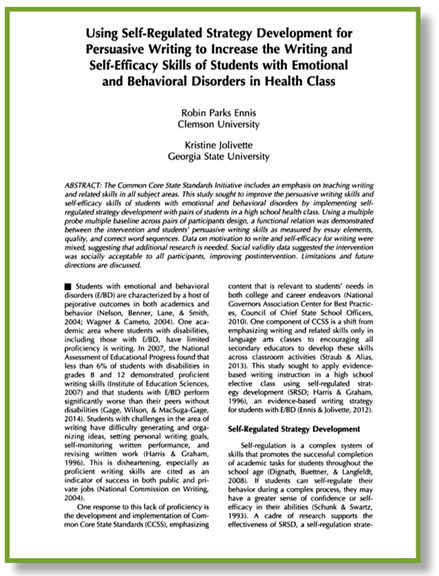
Using Self-Regulated Strategy Development for Persuasive Writing to Increase the Writing and Self-Efficacy Skills of Students with Emotional and Behavioral Disorders in Health Class
Ennis and Jolivette (2014)
The Common Core State Standards emphasize the importance of teaching writing across all subject areas, including non-traditional writing contexts like health classes. This study focused on enhancing the persuasive writing...
The Common Core State Standards emphasize the importance of teaching writing across all subject areas, including non-traditional writing contexts like health classes. This study focused on enhancing the persuasive writing skills and self-efficacy of high school students with emotional and behavioral disorders (EBD) through Self-Regulated Strategy Development (SRSD). SRSD was implemented with pairs of students in a health class, using a multiple baseline design to measure its effectiveness. The intervention positively impacted students’ persuasive writing, with improved essay structure, overall quality, and correct word sequences. While the results for students’ motivation to write and self-efficacy were mixed, additional research may clarify these outcomes. Participants viewed the intervention as socially acceptable, with positive feedback reported after its implementation. The study highlights SRSD’s potential to support writing skills for students with EBD in diverse classroom settings while noting areas for further exploration.
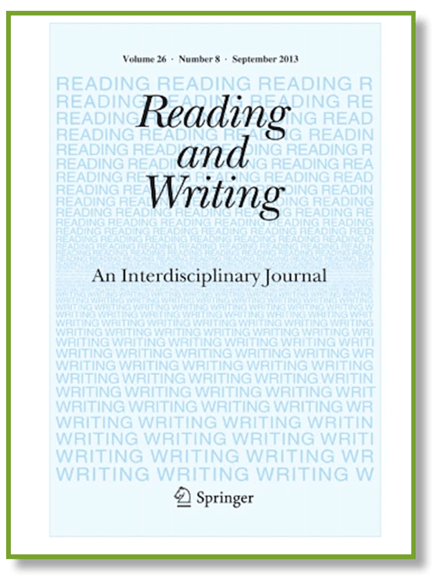
Writing Expository Essays from Social Studies Texts: A Self-Regulated Strategy Development Study
Collins et al. (2021)
This study explored how teaching third graders to write expository essays using the Self-Regulated Strategy Development (SRSD) approach impacted their writing skills, particularly in social studies. Fourteen general education teachers were randomly...
This study explored how teaching third graders to write expository essays using the Self-Regulated Strategy Development (SRSD) approach impacted their writing skills, particularly in social studies. Fourteen general education teachers were randomly assigned to implement SRSD or continue their usual teaching methods, with 180 students participating. Teachers using SRSD received 12 hours of professional development and biweekly coaching over 16 weeks. Initially, teachers introduced the TIDE strategy (Topic Sentence, Important Details, Explain Details, Ending) for planning and writing expository essays, extending it to include close reading and writing about social studies texts. Students who learned with SRSD wrote essays with significantly more structure, higher quality, and better content when using a source text and from memory. They also outperformed their peers on standardized writing assessments. These results highlight SRSD’s effectiveness in general education and its potential for integrating writing with reading and social studies instruction.
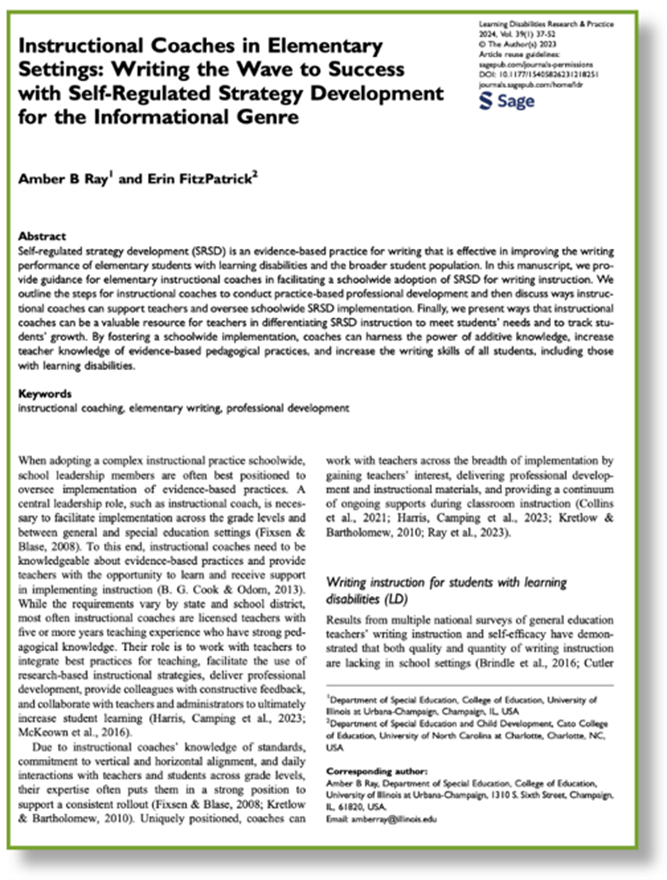
Instructional Coaches in Elementary Settings: Writing the Wave to Success with Self-Regulated Strategy Development for the Informational Genre
Ray and FitzPatrick (2024)
This article offers guidance for elementary instructional coaches on facilitating schoolwide adoption of SRSD for writing instruction. It outlines steps for conducting practice-based professional development, supporting teachers, and overseeing the...
This article offers guidance for elementary instructional coaches on facilitating schoolwide adoption of SRSD for writing instruction. It outlines steps for conducting practice-based professional development, supporting teachers, and overseeing the implementation of SRSD across the school. Additionally, it discusses how instructional coaches can assist teachers in differentiating SRSD instruction to meet diverse student needs and monitor student progress. By promoting schoolwide implementation, coaches can leverage collective knowledge, enhance teacher proficiency in evidence-based practices, and improve writing skills for all students. Self-regulated strategy development (SRSD) is an evidence-based approach that significantly enhances the writing performance of elementary students, including those with learning disabilities and the broader student population.
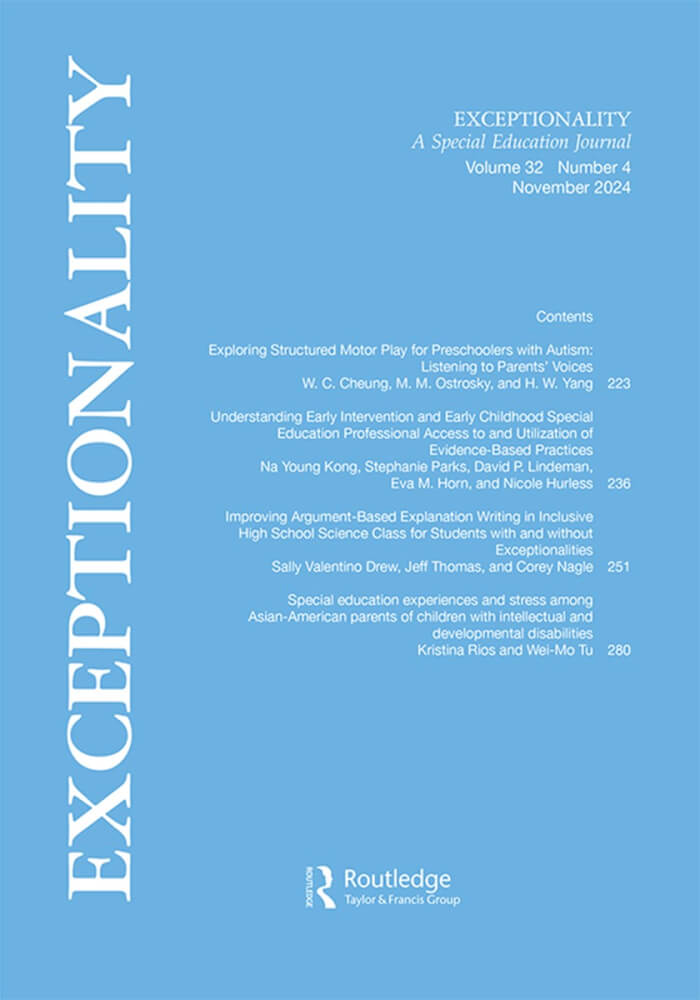
Multilevel meta-analysis of the effectiveness of self-regulated strategy development in writing for children with ASD
Asaro-Saddler et al. (2021)
This study used a multilevel meta-analysis to examine the effectiveness of Self-Regulated Strategy Development (SRSD) in improving the writing skills of students with autism spectrum disorder (ASD). Specifically, it investigated...
This study used a multilevel meta-analysis to examine the effectiveness of Self-Regulated Strategy Development (SRSD) in improving the writing skills of students with autism spectrum disorder (ASD). Specifically, it investigated whether SRSD significantly enhances the number of words written and the overall quality of writing, whether the effects were consistent across studies, and whether age influenced these outcomes. Results revealed that SRSD had a strong and meaningful impact on the quantity and quality of writing. However, there needed to be more variability in its effectiveness across individual cases and studies. Older students demonstrated more significant gains in the number of words written, though age did not affect overall writing quality. The study discusses practical implications for educators and offers recommendations for future research.
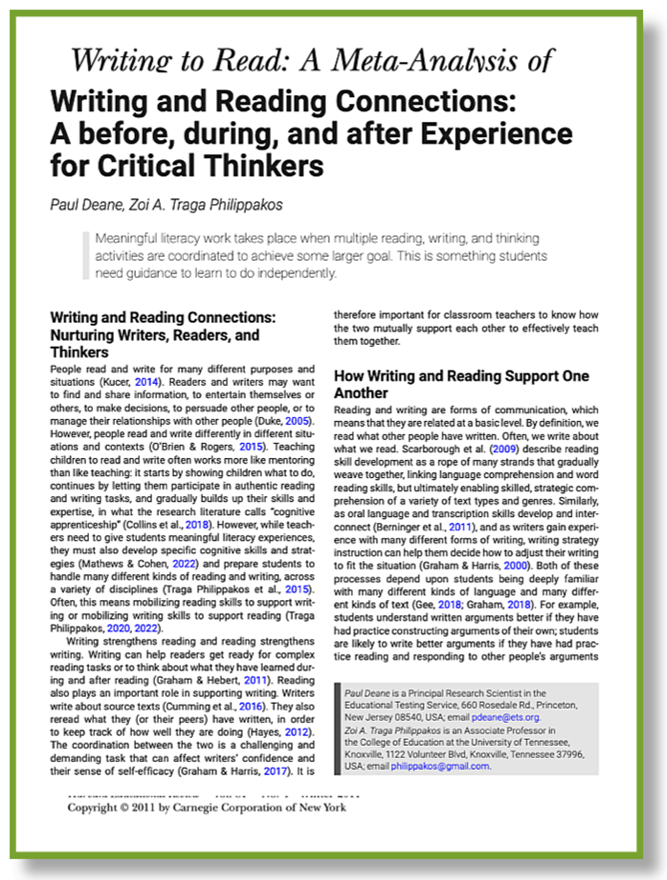
Writing and Reading Connections: A before, during, and after Experience for Critical Thinkers
Deane and Philippakos (2024)
The study Writing and Reading Connections: Nurturing Writers, Readers, and Thinkers examines the symbiotic relationship between writing and reading, highlighting how each skill reinforces the other. It explores how writing tasks, such...
The study Writing and Reading Connections: Nurturing Writers, Readers, and Thinkers examines the symbiotic relationship between writing and reading, highlighting how each skill reinforces the other. It explores how writing tasks, such as summarizing or note-taking, can improve reading comprehension, while reading tasks, like analyzing texts or gathering evidence, can support effective writing. The study emphasizes the importance of integrating writing-to-read and reading-to-write activities in the classroom, showcasing strategies like using graphic organizers, prereading “thinksheets,” and peer review prompts to scaffold student learning. By fostering these reciprocal literacy practices, the study demonstrates how educators can help students develop critical thinking, deepen text comprehension, and enhance written expression. The research provides actionable insights for teachers to design lessons that align reading and writing goals, preparing students for complex, real-world literacy challenges.
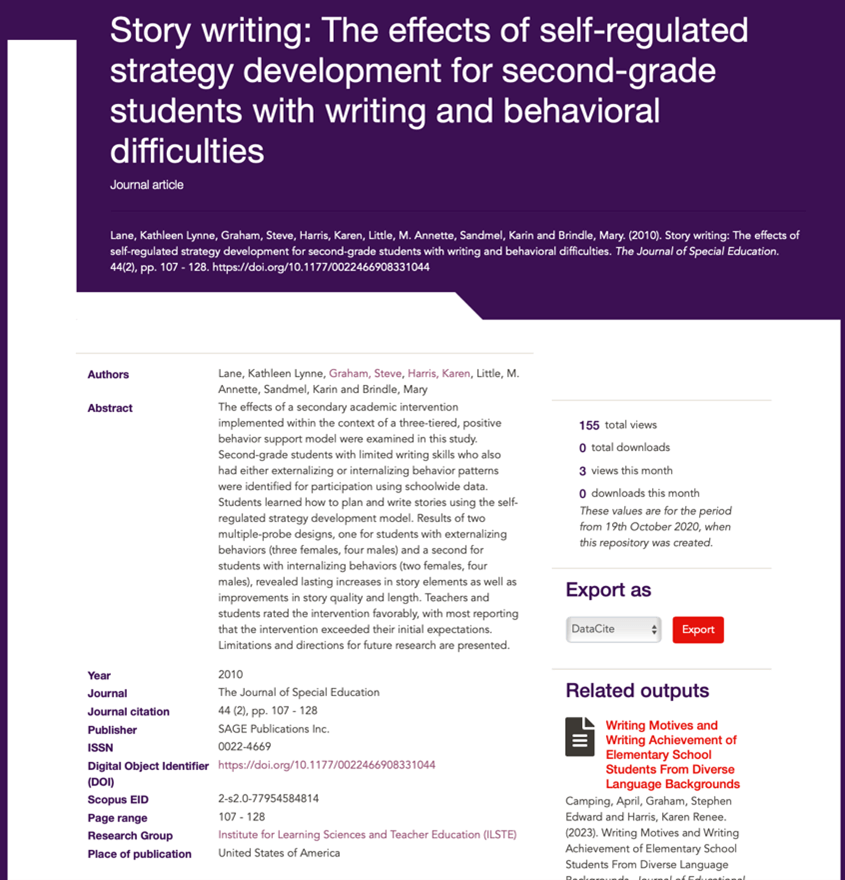
Story Writing: The Effects of Self-Regulated Strategy Development for Second-Grade Students with Writing and Behavioral Difficulties
Lane et al. (2009)
This study explored the impact of a secondary academic intervention integrated within a three-tiered positive behavior support model for second-grade students with limited writing skills and either externalizing or internalizing...
This study explored the impact of a secondary academic intervention integrated within a three-tiered positive behavior support model for second-grade students with limited writing skills and either externalizing or internalizing behavior patterns. Using schoolwide data, researchers identified students who then learned to plan and write stories using the Self-Regulated Strategy Development (SRSD) model. Results from two multiple-probe designs—one for students with externalizing behaviors (three females, four males) and another for students with internalizing behaviors (two females, four males)—showed lasting improvements in story elements, quality, and length. Both teachers and students rated the intervention highly, with many noting that it exceeded their expectations. The study highlights SRSD’s effectiveness for diverse student needs while also noting limitations and suggesting areas for future research.
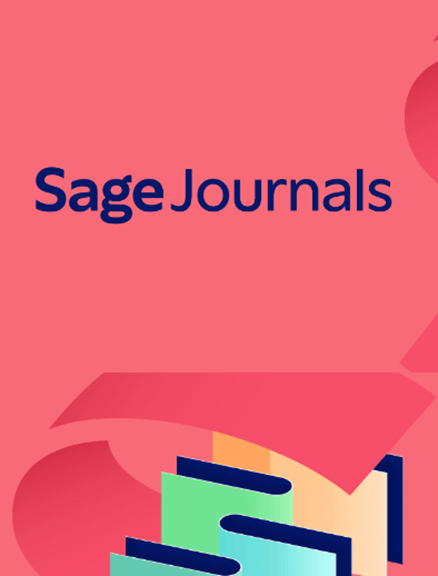
Self-Regulated Strategy Development: Connecting Persuasive Writing to Self-Determination for Youth in Juvenile Justice Facilities
Pitzel et al. (2023)
Adolescent girls in juvenile justice settings often face significant challenges with the writing process, limiting their ability to communicate ideas and advocate for themselves effectively. This study examined the impact...
Adolescent girls in juvenile justice settings often face significant challenges with the writing process, limiting their ability to communicate ideas and advocate for themselves effectively. This study examined the impact of combining Self-Regulated Strategy Development (SRSD) with self-determination skills to teach persuasive writing as a self-advocacy tool. Participants learned to write persuasive pieces advocating for their wants and needs. Using a multiple-probe-across-participants design, researchers assessed the effectiveness of this approach. Results showed a clear link between SRSD with self-determination instruction and improved writing skills. All participants demonstrated significant growth in the organizational quality of their writing and their ability to incorporate self-advocacy from baseline to independent practice. While the study underscores the potential of SRSD to empower youth in alternative education settings, it also identifies limitations and suggests areas for future research.
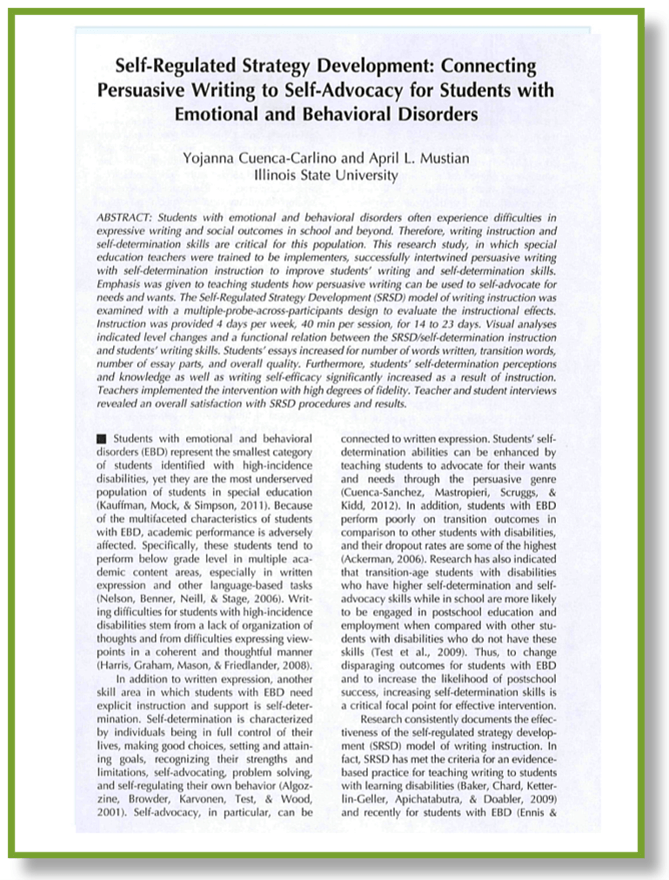
Self-Regulated Strategy Development: Connecting Persuasive Writing to Self-Advocacy for Students with Emotional and Behavioral Disorders
Cuenca-Carlino and Mustian (2013)
Students with emotional and behavioral disorders often face challenges with expressive writing and self-advocacy, which can affect their social and academic outcomes. This study explored the impact of integrating persuasive...
Students with emotional and behavioral disorders often face challenges with expressive writing and self-advocacy, which can affect their social and academic outcomes. This study explored the impact of integrating persuasive writing instruction with self-determination skills, emphasizing how persuasive writing can be used as a tool for self-advocacy. Special education teachers, trained to deliver the intervention, implemented the Self-Regulated Strategy Development (SRSD) model using a multiple-probe-across-participants design. Students received 40-minute sessions, four days a week, over 14 to 23 days. Results showed a strong connection between the intervention and improvements in students’ writing skills, including the number of words written, use of transition words, inclusion of essay parts, and overall quality. Additionally, students demonstrated increased self-determination knowledge, writing self-efficacy, and confidence in their abilities. Teachers implemented the program with high fidelity, and interviews with both teachers and students reflected high satisfaction with the SRSD approach and its outcomes.
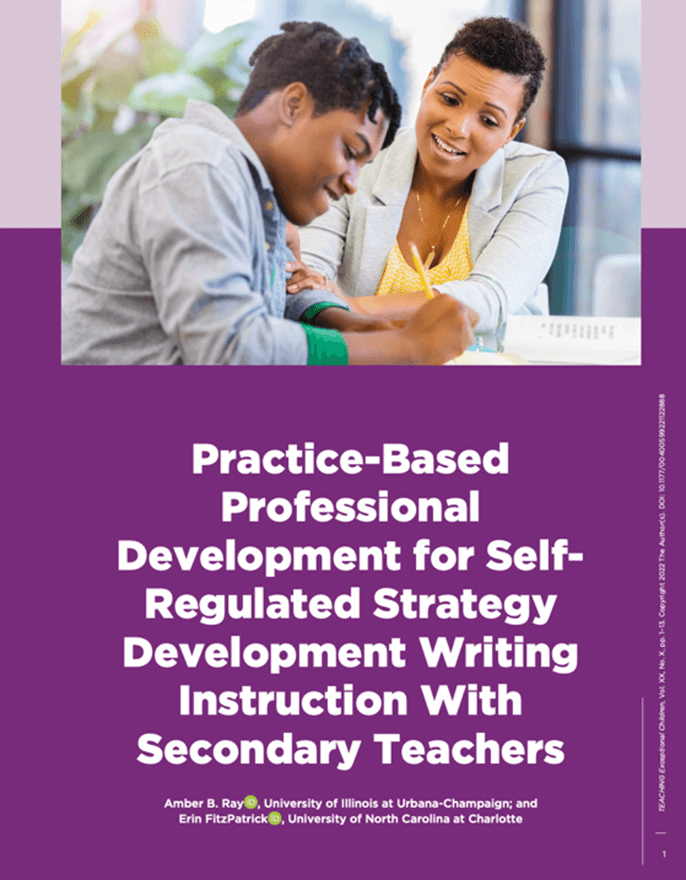
Practice-Based Professional Development for Self-Regulated Strategy Development Writing Instruction with Secondary Teachers
Ray and FitzPatrick (2022)
Students with disabilities require high-quality instruction to effectively use writing as a powerful tool for academic and economic success. Self-regulated strategy development (SRSD) is a proven intervention that significantly enhances...
Students with disabilities require high-quality instruction to effectively use writing as a powerful tool for academic and economic success. Self-regulated strategy development (SRSD) is a proven intervention that significantly enhances writing performance for students with learning disabilities, emotional and behavioral disorders, and attention deficit hyperactivity disorder. Additionally, SRSD benefits general education students at the secondary level and supports knowledge acquisition in reading and content areas. However, SRSD is a complex intervention that necessitates intensive support through professional development. This manuscript provides a detailed guide for instructional coaches and teacher leaders on supporting middle and high school teachers in adopting SRSD through a practice-based professional development model. It includes step-by-step directions for planning, implementing, supporting, and evaluating the implementation of this evidence-based writing practice.

Writing from Multiple Source Texts: SRSD for Fifth Grade Learners in Inclusive Settings
FitzPatrick and McKeown (2021)
This study examined how a fifth-grade special education teacher in an inclusive classroom implemented Self-Regulated Strategy Development (SRSD) to teach informational writing to eight Black students, five with Individualized Education...
This study examined how a fifth-grade special education teacher in an inclusive classroom implemented Self-Regulated Strategy Development (SRSD) to teach informational writing to eight Black students, five with Individualized Education Programs (IEPs), and three referred by their teachers. After receiving professional development, the teacher delivered SRSD with high fidelity, leading to significant improvements in students’ writing, including better use of genre elements, increased length and quality, enhanced strategy use, and expanded academic vocabulary while reducing text copying from sources. The teacher and students rated SRSD highly for its effectiveness and ease of use, demonstrating its value in supporting diverse learners in inclusive settings.

Practice-Based Professional Development for Self-Regulated Strategy Development Writing Instruction with Secondary Teachers
Ray and FitzPatrick (2022)
Students with disabilities need strong, effective instruction to use writing as a tool for academic and future economic success. Self-Regulated Strategy Development (SRSD) is a proven method that significantly boosts...
Students with disabilities need strong, effective instruction to use writing as a tool for academic and future economic success. Self-Regulated Strategy Development (SRSD) is a proven method that significantly boosts writing skills for students with learning disabilities, emotional and behavioral disorders, and ADHD. Additionally, SRSD has shown success in general education settings at the secondary level and supports both reading and content knowledge development. However, SRSD is a complex strategy that requires thorough professional development to implement effectively. This article provides instructional coaches and teacher leaders with a detailed guide to supporting middle and high school teachers adopting SRSD. It includes step-by-step instructions for planning, implementing, supporting, and evaluating SRSD using a practice-based professional development model.

Instructional Coaches in Elementary Settings: Writing the Wave to Success with Self-Regulated Strategy Development for the Informational Genre
Ray and FitzPatrick (2024)
Self-Regulated Strategy Development (SRSD) is a proven writing instruction method that improves the writing skills of elementary students, including those with learning disabilities and the general student population. This article...
Self-Regulated Strategy Development (SRSD) is a proven writing instruction method that improves the writing skills of elementary students, including those with learning disabilities and the general student population. This article provides elementary instructional coaches with a clear roadmap for guiding a schoolwide adoption of SRSD. It outlines the steps for conducting practice-based professional development, supporting teachers in their classrooms, and managing the overall implementation process. Additionally, it highlights how coaches can help teachers differentiate SRSD instruction to meet diverse student needs and monitor student growth. By leading a schoolwide effort, instructional coaches can build collective knowledge, enhance teacher expertise in evidence-based practices, and strengthen all students’ writing abilities.

Improving Informative Writing in Inclusive and Linguistically-Diverse Elementary Classes through Self-Regulated Strategy Development
Ray et al. (2023)
Developing strong informative writing skills in elementary school is essential for students’ long-term academic and personal success. This study explored the effects of a schoolwide implementation of Self-Regulated Strategy Development...
Developing strong informative writing skills in elementary school is essential for students’ long-term academic and personal success. This study explored the effects of a schoolwide implementation of Self-Regulated Strategy Development (SRSD) in inclusive classrooms on both students’ writing performance and teachers’ confidence and perceptions of teaching SRSD. Eighteen kindergarten through fifth-grade teachers participated in professional development and taught SRSD to 276 students. Using multilevel modeling, researchers examined how student outcomes varied based on gender, educational classification (general education, special education, English Learners [ELs], or a combination), and the number of lessons completed. Students across all grades significantly improved genre elements, holistic quality, total words written, and transition word usage. Importantly, gains in genre elements, holistic quality, and transition words remained significant regardless of student gender, classification, or the number of lessons received. Teachers also reported feeling more confident and skilled in teaching writing through SRSD, highlighting the dual benefits of this evidence-based instructional approach for both students and educators.
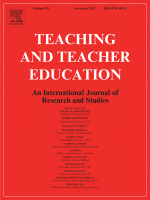
Teacher-implemented self-regulated strategy development instruction for story writing with year 2 students in Aotearoa/New Zealand: A mixed methods study
Finlayson & McCrudden (2022)
Teaching writing to young students is often challenging, as writing is a complex skill many struggle to master. Self-Regulated Strategy Development (SRSD) is an evidence-based writing intervention that successfully improves...
Teaching writing to young students is often challenging, as writing is a complex skill many struggle to master. Self-Regulated Strategy Development (SRSD) is an evidence-based writing intervention that successfully improves students’ writing. Still, limited research exists on its use with younger primary students, primarily when implemented by classroom teachers. This study explored the effectiveness and social validity of teacher-led SRSD interventions in Year 2 (ages 6–7) classrooms in New Zealand. Two mixed-methods studies were conducted: the first involved a 5-week, 19-lesson program, and the second a 17-week, 61-lesson program. In the quantitative component, students receiving SRSD instruction showed significantly more significant gains in holistic quality, story elements, and composition length than in regular writing instruction. The qualitative component included teacher interviews, which revealed that teachers found the intervention beneficial for students, appropriate for the classroom, and enjoyable to implement. These findings suggest that teacher-led SRSD interventions effectively improve young students’ writing skills and are well-received by educators.
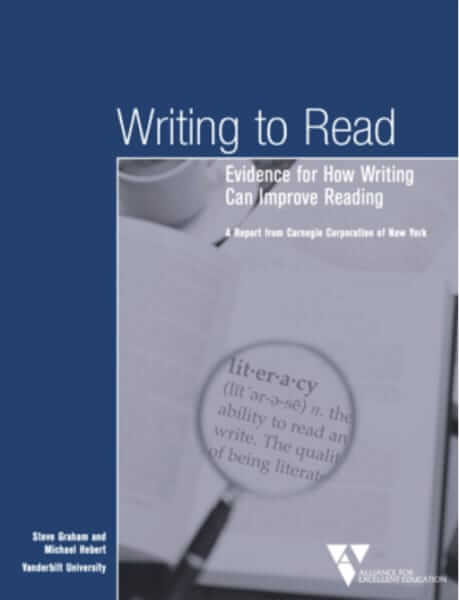
Writing to Read: Evidence for How Writing Can Improve Reading
2010
Over the past decade, numerous efforts, including studies like Reading Next (Biancarosa and Snow, 2004) and reviews by Scammacca et al. (2007) and Graham and Perin (2007a), have aimed to...
Over the past decade, numerous efforts, including studies like Reading Next (Biancarosa and Snow, 2004) and reviews by Scammacca et al. (2007) and Graham and Perin (2007a), have aimed to improve adolescent literacy skills. Writing, often overlooked, can enhance reading comprehension by helping students record, analyze, and connect ideas. This report “Writing to Read: Evidence for How Writing Can Improve Reading” by Steve Graham and Michael Hebert, published by the Alliance for Excellent Education and funded by the Carnegie Corporation of New York, explores the significant but often underappreciated relationship between writing and reading. The report identifies three core instructional practices that effectively boost reading skills through writing. It emphasizes integrating writing into the reading curriculum to enhance learning and comprehension. Part of a broader initiative to reform literacy instruction, “Writing to Read” builds on the foundation laid by the earlier “Time to Act” reports, aiming to advance adolescent literacy for college and career readiness. The report calls for more attention from researchers and policymakers on writing instruction as a crucial element of educational programs, advocating for a holistic approach to literacy that acknowledges the interconnectivity of reading and writing.
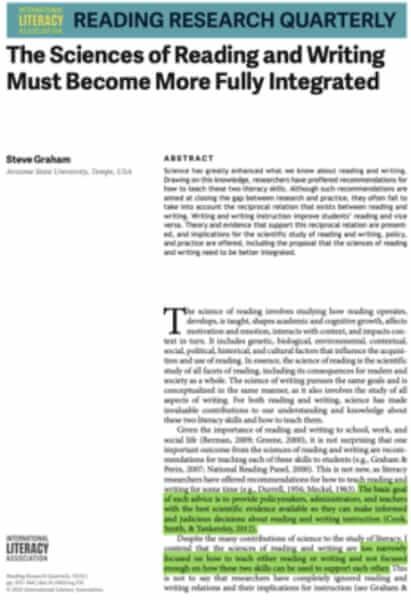
The Science of Reading and Writing Must Become More Fully Integrated
2020
Science has significantly expanded our understanding of reading and writing, leading to teaching recommendations that often overlook the reciprocal relationship between these skills. Improvement in one enhances the other, as...
Science has significantly expanded our understanding of reading and writing, leading to teaching recommendations that often overlook the reciprocal relationship between these skills. Improvement in one enhances the other, as shown by strong theoretical and empirical support. The study “The Sciences of Reading and Writing Must Become More Fully Integrated” emphasizes the need for integrated literacy instruction to enhance both skills. It discusses the implications for policy, practice, and research, proposing better integration to bridge the gap between research and educational practice for more effective literacy education. Steve Graham argues that integrating reading and writing in educational practices can enhance teaching effectiveness based on empirical evidence showing mutual reinforcement between the two skills. He advocates for educational policies and classroom strategies that embrace this integrated approach, suggesting that such a framework can improve student outcomes in literacy. Theoretical perspectives support this call for integration and aim to bridge the gap between research findings and practical application in educational settings.
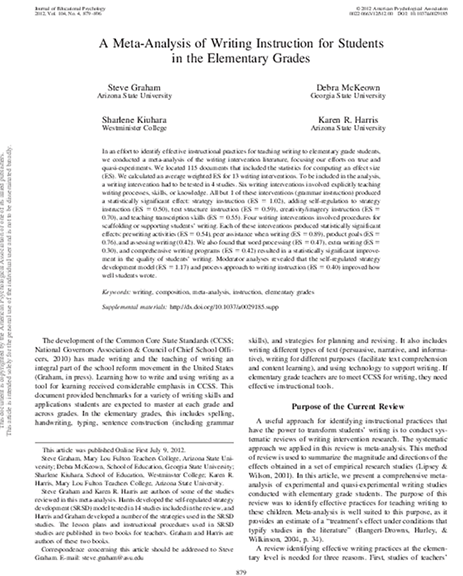
Reading for Writing: A Meta-Analysis of the Impact of Reading Interventions on Writing
2017
This meta-analysis examined whether reading interventions improve students’ writing performance, analyzing 54 experiments (5,018 students) teaching reading and 36 investigations (3,060 students) increasing interaction with text. The studies included true-...
This meta-analysis examined whether reading interventions improve students’ writing performance, analyzing 54 experiments (5,018 students) teaching reading and 36 investigations (3,060 students) increasing interaction with text. The studies included true- or quasi-experiments with pretests in English from preschool to Grade 12. Exclusions applied if the control condition was a writing intervention, if treatment students received writing instruction, or if there were high attrition rates or small sample sizes. Results showed teaching reading significantly improved writing (ES = 0.57) and maintained effects over time (ES = 0.37). Reading text or observing others also enhanced writing (ES = 0.35). This study supports the integration of reading and writing instruction to enhance literacy skills.
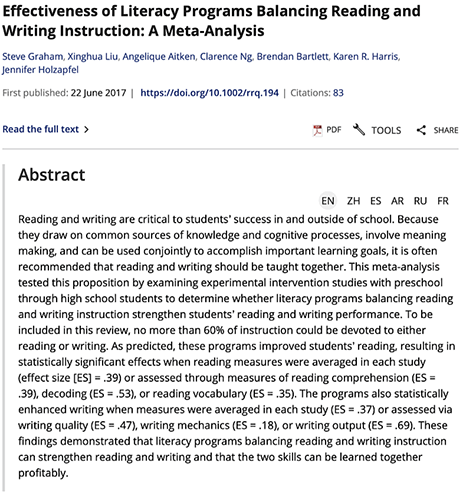
Effectiveness of Literacy Programs Balancing Reading and Writing Instruction: A Meta‐Analysis
2017
The 2018 meta-analysis by Graham et al., titled “Effectiveness of Literacy Programs Balancing Reading and Writing Instruction,” evaluates the impact of integrated literacy programs. Reading and writing are crucial for...
The 2018 meta-analysis by Graham et al., titled “Effectiveness of Literacy Programs Balancing Reading and Writing Instruction,” evaluates the impact of integrated literacy programs. Reading and writing are crucial for students’ success both in school and beyond, sharing common cognitive processes and meaning-making functions. The meta-analysis examined studies from preschool to high school, showing that programs with no more than 60% of instruction focused on either skill significantly improved reading (ES = .39) and writing (ES = .37). The findings highlight that balanced literacy instruction enhances both skills and offers broader educational benefits, supporting its implementation in curricula to boost overall literacy proficiency.
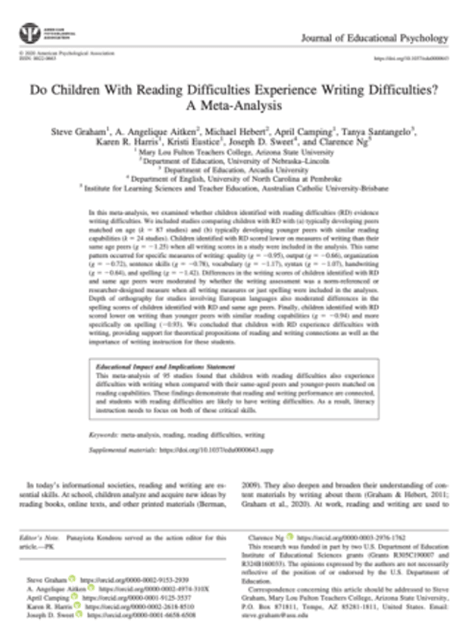
Do Children with Reading Difficulties Experience Writing Difficulties? A Meta-Analysis
2020
The 2020 meta-analysis by Graham and colleagues explores the relationship between reading and writing difficulties in children. Titled “Do children with reading difficulties experience writing difficulties?”, this study rigorously analyzes...
The 2020 meta-analysis by Graham and colleagues explores the relationship between reading and writing difficulties in children. Titled “Do children with reading difficulties experience writing difficulties?”, this study rigorously analyzes existing research to determine if struggles in reading are inherently linked to impairments in writing. The findings confirm a strong correlation, indicating that children who face challenges in reading also tend to exhibit significant difficulties in writing. This comprehensive analysis highlights the interconnected nature of literacy skills and underscores the necessity for integrated interventions that address both reading and writing to support struggling students effectively. Studies included no more than 60% of instruction focused on either skill. Results showed significant improvements in reading (ES = .39) and writing (ES = .37). Specifically, reading comprehension (ES = .39), decoding (ES = .53), and vocabulary (ES = .35) improved, as did writing quality (ES = .47), mechanics (ES = .18), and output (ES = .69). These findings support integrated literacy instruction.
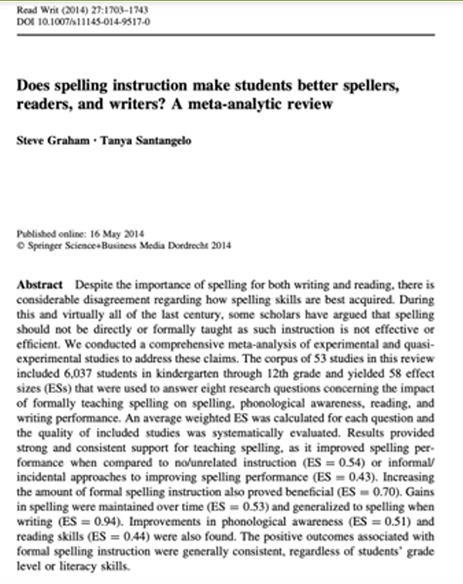
Does Spelling Instruction Make Students Better Spellers, Readers, and Writers? A Meta-Analytic Review
2014
In the 2014 meta-analytic review by Graham and Santangelo, titled “Does spelling instruction make students better spellers, readers, and writers?” the authors examine the impact of explicit spelling instruction on...
In the 2014 meta-analytic review by Graham and Santangelo, titled “Does spelling instruction make students better spellers, readers, and writers?” the authors examine the impact of explicit spelling instruction on students’ spelling, reading, and writing abilities. The review aggregates results from various studies to assess whether teaching spelling improves literacy skills beyond accurate spelling. The findings indicate that targeted spelling instruction enhances spelling proficiency and contributes positively to reading and writing capabilities. This suggests that spelling is a foundational skill that supports broader academic competencies in literacy, highlighting the importance of including focused spelling strategies within the literacy curriculum. Despite the importance of spelling for writing and reading, there is considerable disagreement on teaching spelling. Some scholars argue against direct instruction, claiming it is ineffective. A meta-analysis of 53 studies involving 6,037 K-12 students was conducted to address these claims, yielding 58 effect sizes. The analysis found strong support for formal spelling instruction, improving spelling performance (ES = 0.54), phonological awareness (ES = 0.51), and reading skills (ES = 0.44). Increased formal instruction further enhanced spelling (ES = 0.70) and generalized to writing (ES = 0.94). These benefits were consistent across grade levels and literacy skills.
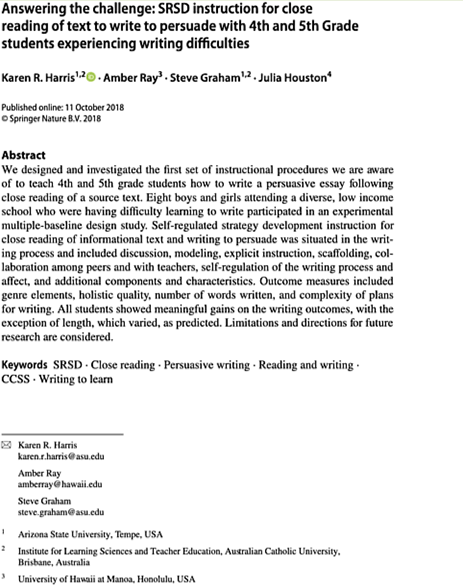
Answering the Challenge: SRSD Instruction for Close Reading of Text to Write to Persuade with 4th and 5th Grade Students Experiencing Writing Difficulties
2019
The study titled “Answering the Challenge: SRSD Instruction for Close Reading of Text to Write to Persuade with 4th and 5th Grade Students Experiencing Writing Difficulties” conducted by Harris, Ray,...
The study titled “Answering the Challenge: SRSD Instruction for Close Reading of Text to Write to Persuade with 4th and 5th Grade Students Experiencing Writing Difficulties” conducted by Harris, Ray, Graham, and Houston investigates the efficacy of Self-Regulated Strategy Development (SRSD) in improving persuasive writing skills among struggling young writers. The study in a Title 1 school involved eight students who underwent a multiple-baseline design experiment. The results demonstrated substantial gains in including genre elements in their essays, increasing from an average of 7.44 elements at baseline to 21.79 post-instruction. Holistic quality scores also improved significantly, with all students showing meaningful enhancements in their writing. However, the essays’ length varied and was consistent with predictions. Maintenance data indicated sustained improvements, though additional booster sessions might be necessary for long-term retention. Overall, the study underscores the effectiveness of SRSD in fostering better writing skills through close reading and persuasive writing instruction tailored to individual student needs.
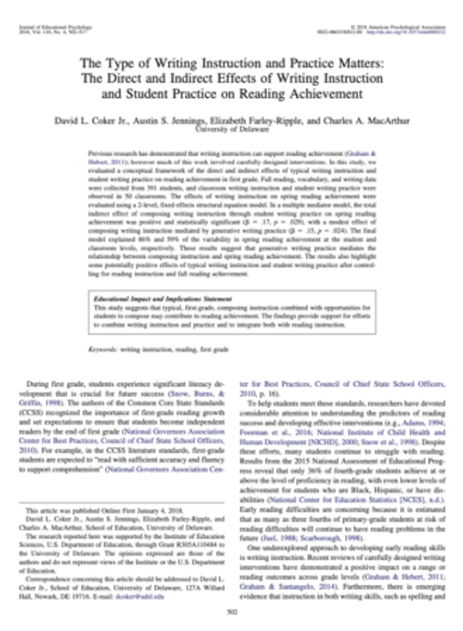
The Type of Writing Instruction and Practice Matters: The Direct and Indirect Effects of Writing Instruction and Student Practice on Reading Achievement
2018
Previous research has shown that writing instruction can support reading achievement. This study evaluated a framework for the direct and indirect effects of typical writing instruction and student writing practice...
Previous research has shown that writing instruction can support reading achievement. This study evaluated a framework for the direct and indirect effects of typical writing instruction and student writing practice on first-grade reading achievement. Data from 391 students were collected in the fall, including reading, vocabulary, and writing assessments; writing instruction and practice were observed in 50 classrooms. Using a 2-level structural equation model, the study found that the indirect effect of composing writing instruction through student writing practice on spring reading achievement was positive and statistically significant (β = .17, p = .029). Generative writing practice mediated the relationship between composing instruction and spring reading achievement (β = .15, p = .024). The final model explained 86% of the variability in spring reading achievement at the student level and 59% at the classroom level. These findings suggest that generative writing practice is a key mediator between writing instruction and reading achievement. The study highlights the potential positive effects of typical writing instruction and student writing practice on reading skills, emphasizing the need for diverse writing tasks that promote critical thinking and synthesis of information. Educators can strategically enhance students’ reading development by incorporating such tasks into the curriculum.
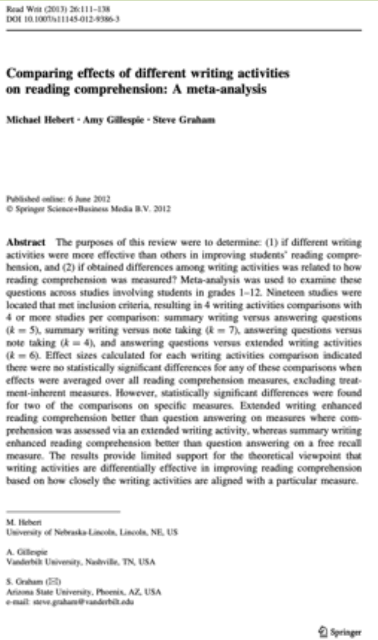
Comparing Effects of Different Writing Activities on Reading Comprehension: A Meta-Analysis
2012
This review determined if certain writing activities are more effective than others in improving student’s reading comprehension and whether these differences relate to how comprehension is measured. A meta-analysis of...
This review determined if certain writing activities are more effective than others in improving student’s reading comprehension and whether these differences relate to how comprehension is measured. A meta-analysis of 19 studies involving grades 1-12 compared four writing activities: summary writing vs. answering questions (k = 5), summary writing vs. note-taking (k = 7), answering questions vs. note-taking (k = 4), and answering questions vs. extended writing (k = 6). Results showed no significant differences across all measures. Still, specific measures revealed that extended writing improved comprehension better than question answering when assessed through extended writing activities, and summary writing was more effective than question answering on free recall measures. These findings suggest that aligning writing activities with specific comprehension measures can influence their effectiveness.
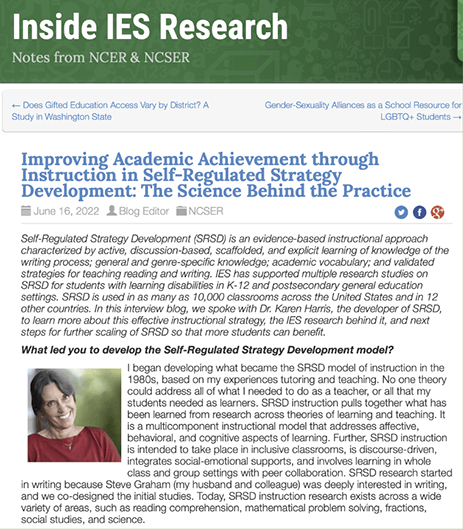
Improving Academic Achievement through Instruction in Self-Regulated Strategy Development: The Science Behind the Practice
2022
SRSD research typically shows large effect sizes, exceeding 0.85 in meta-analyses, with ranges from 1.0 to 2.55 across writing and affective outcome measures. This blog on Self-Regulated Strategy Development (SRSD)...
SRSD research typically shows large effect sizes, exceeding 0.85 in meta-analyses, with ranges from 1.0 to 2.55 across writing and affective outcome measures. This blog on Self-Regulated Strategy Development (SRSD) highlights it as an evidence-based instructional approach integrating active, scaffolded, and explicit learning of writing processes and academic strategies. Developed by Dr. Karen Harris in the 1980s, SRSD addresses cognitive, behavioral, and affective learning aspects. Research supported by IES shows SRSD’s efficacy across various educational levels, demonstrating significant improvements in writing skills, self-efficacy, and self-regulation. The SRSD model is used in thousands of classrooms globally, with ongoing research aimed at further adaptation and scaling. Challenges remain in widespread implementation, requiring collaboration with educators and administrators.
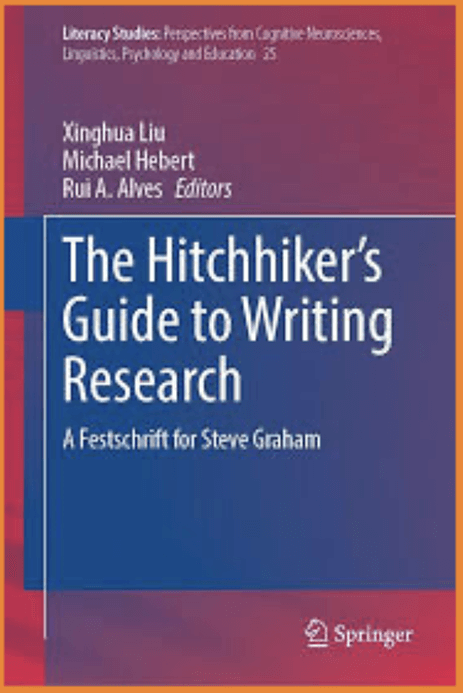
Hitching a Ride with Steve Graham through the Galaxy of Writing Research
2023
Steve Graham’s legacy as a writing researcher may be best represented through his systematic reviews and meta-analyses. Through his reviews, he has hitchhiked through the literature and provided the field...
Steve Graham’s legacy as a writing researcher may be best represented through his systematic reviews and meta-analyses. Through his reviews, he has hitchhiked through the literature and provided the field with a guide to the galaxy of writing research. The purpose of this chapter was to review Graham’s systematic reviews and place them within the context of a scoping review of all of the other systematic reviews of writing research. To do this, we conducted two separate reviews. First, we identified all of the reviews of writing research on Steve Graham’s curriculum vitae and grouped and reviewed them by type. Second, we conducted a scoping review of the writing research. We identified 317 systematic reviews of the writing literature, of which 40 (13%) involved Steve Graham as an author. Of the 277 reviews that did not include Steve Graham as an author, 117 (42%) cited Graham at least once. Graham’s reviews have spanned 44 years (and counting) and included more than 2900 studies. We classified Graham’s reviews into three primary types: (1) instructional effectiveness, (2) group comparisons, and (3) general non-systematic reviews. Some of the major findings of Graham’s work include (a) the identification of more than 30 effective general practices for improving writing outcomes for students, (b) writing and writing instruction improve reading and content learning, (c) students who are at-risk for learning difficulties due to reading, language, or ADHD also tend to perform lower than their typically developing peers in writing, and (d) some of his general reviews of the literature show a more complete picture of the writing literature in a particular area. The discussion includes ideas for how Graham’s work might be used to inform future writing research.
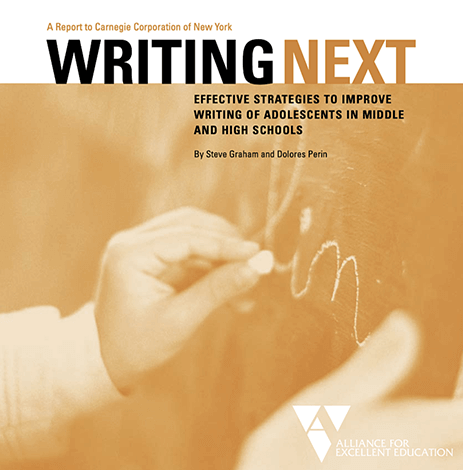
Writing Next: Effective Strategies to Improve Writing of Adolescents
Graham & Perin, 2007
Commissioned by the Carnegie Corporation, this influential report synthesizes research to identify effective writing instruction strategies for adolescents, highlighting SRSD’s impact on middle and high school students. This report offers...
Commissioned by the Carnegie Corporation, this influential report synthesizes research to identify effective writing instruction strategies for adolescents, highlighting SRSD’s impact on middle and high school students. This report offers evidence-based strategies to improve writing for 4th- to 12th-grade students. It highlights the need for all students, especially struggling writers, to become proficient and flexible writers. “Writing Next” presents 11 effective elements for adolescent writing instruction, including teaching strategies for planning, revising, summarization, collaborative writing, setting specific goals, using word processors, sentence combining, prewriting, inquiry activities, process writing approaches, studying models, and writing for content learning. These elements enhance writing instruction and stimulate policy and research discussions to improve literacy nationwide.
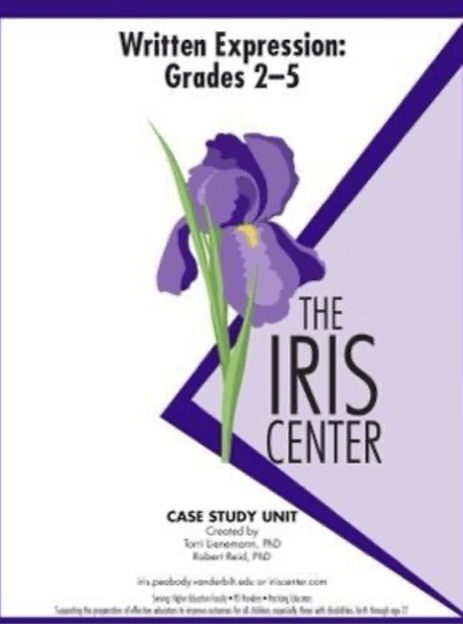
Written Expression Grades 2-5
2009
The IRIS case study “Written Expression: Grades 2-5” addresses the challenges elementary and middle school students face with both lower-level and higher-level writing skills. Lower-level skills include handwriting, spelling, and...
The IRIS case study “Written Expression: Grades 2-5” addresses the challenges elementary and middle school students face with both lower-level and higher-level writing skills. Lower-level skills include handwriting, spelling, and grammar, while higher-level skills involve idea formulation, planning, organizing, and revising text. The study engages students in active learning and self-regulation by introducing targeted strategies through the Self-Regulated Strategy Development (SRSD) model. Strategies such as POW + WWW, What=2, How=2 for narratives, and POW + TREE for persuasive essays help students systematically plan and organize their writing, improving confidence and competence. For instance, implementing these SRSD strategies has resulted in notable enhancements in the quality and organization of students’ writing, as evidenced by increased narrative elements and clearer argumentative structures in persuasive essays. This comprehensive study provides educators with practical tools and interventions to support struggling writers, ultimately enhancing their academic performance and literacy skills.
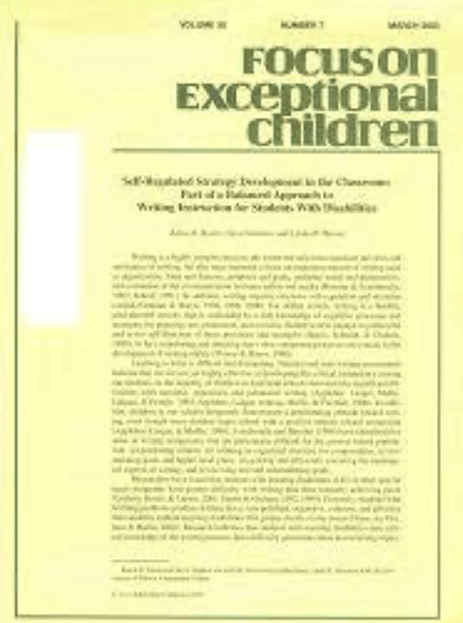
“Self-regulated strategy development in the classroom: Part of a balanced approach to writing instruction for students with disabilities.” Focus on Exceptional Children, 35, 1-16
2003
The study “Self-Regulated Strategy Development in the Classroom: Part of a Balanced Approach to Writing Instruction for Students with Disabilities” by Harris, Graham, and Mason explores the effectiveness of the...
The study “Self-Regulated Strategy Development in the Classroom: Part of a Balanced Approach to Writing Instruction for Students with Disabilities” by Harris, Graham, and Mason explores the effectiveness of the SRSD model in improving writing skills among students with learning disabilities. Writing is a complex process requiring cognitive, behavioral, and self-regulation skills, which many students with learning disabilities struggle to master. The SRSD model addresses these challenges through explicit, tailored instruction that enhances students’ knowledge of writing strategies and ability to self-regulate their writing processes. The study highlights the importance of developing these skills to improve writing quality, coherence, and student engagement. Specific results from the study show that students who received SRSD instruction significantly improved their ability to plan, write, and revise texts. They also showed increased self-efficacy and motivation towards writing. By integrating SRSD into classroom instruction, teachers can provide a structured yet flexible approach that meets the diverse needs of students with learning disabilities. This model not only supports the development of writing skills but also fosters positive attitudes and confidence in students, making it an essential component of a balanced writing instruction program. The study underscores the necessity of explicit, supportive, and individualized instruction to help students with disabilities achieve writing success. It demonstrates the transformative impact of SRSD on students’ writing abilities and overall academic performance.
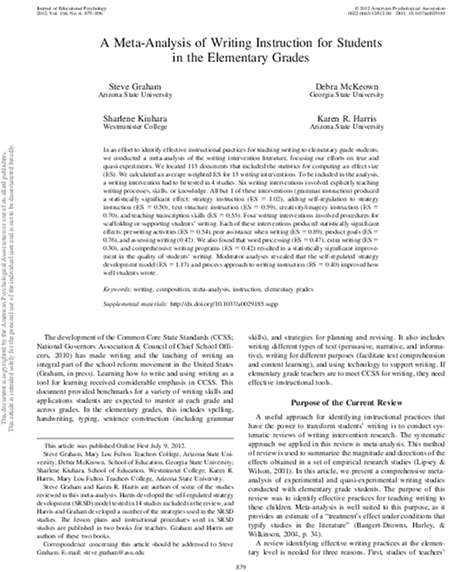
A Meta-Analysis of Writing Instruction for Elementary Students
Graham et al., 2012
This comprehensive meta-analysis evaluates various writing instruction methods, including SRSD, establishing a solid empirical foundation for SRSD’s effectiveness at the elementary level by Graham, McKeow, Kiuhara, and Harris. They calculated...
This comprehensive meta-analysis evaluates various writing instruction methods, including SRSD, establishing a solid empirical foundation for SRSD’s effectiveness at the elementary level by Graham, McKeow, Kiuhara, and Harris. They calculated average effect sizes (ES) for 13 interventions focusing on teaching writing processes, skills, or knowledge, with all but one (grammar instruction) showing significant effects. Four interventions, like prewriting activities (ES = 0.54) and peer assistance (ES = 0.89), involved scaffolding students’ writing and were also effective. Word processing (ES = 0.47), extra writing (ES = 0.30), and comprehensive programs (ES = 0.42) improved writing quality. The self-regulated strategy development model (ES = 1.17) and the process approach to writing instruction (ES = 0.40) significantly enhanced students’ writing.
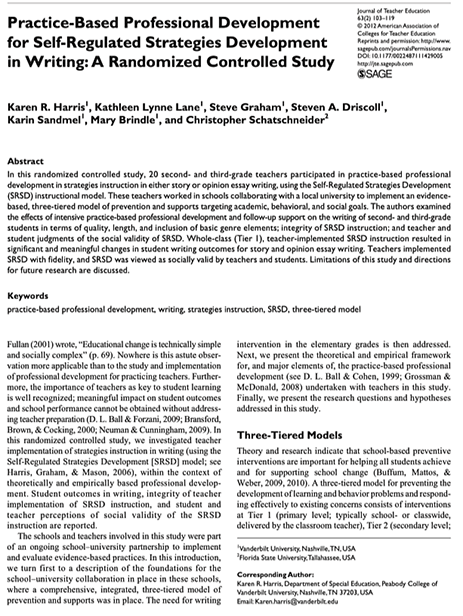
Practice-Based Professional Development for Self-Regulated Strategies Development in Writing
Harris et al., 2012
This randomized controlled study demonstrates the impact of practice-based professional development on teachers’ implementation of SRSD, significantly enhancing student writing outcomes. (20) Second and third-grade teachers received practice-based professional development...
This randomized controlled study demonstrates the impact of practice-based professional development on teachers’ implementation of SRSD, significantly enhancing student writing outcomes. (20) Second and third-grade teachers received practice-based professional development in story or opinion essay writing strategies using the Self-Regulated Strategies Development (SRSD) model. These teachers worked in schools that collaborated with a local university to implement an evidence-based, three-tiered prevention model targeting academic, behavioral, and social goals. The study examined the effects of intensive professional development and follow-up support on student writing quality, length, and inclusion of genre elements, as well as the fidelity of SRSD instruction and its social validity. Whole-class SRSD instruction significantly improved student writing outcomes for story and opinion essays. Teachers implemented SRSD with fidelity, and both teachers and students viewed SRSD as socially valid. Limitations and future research directions are discussed.
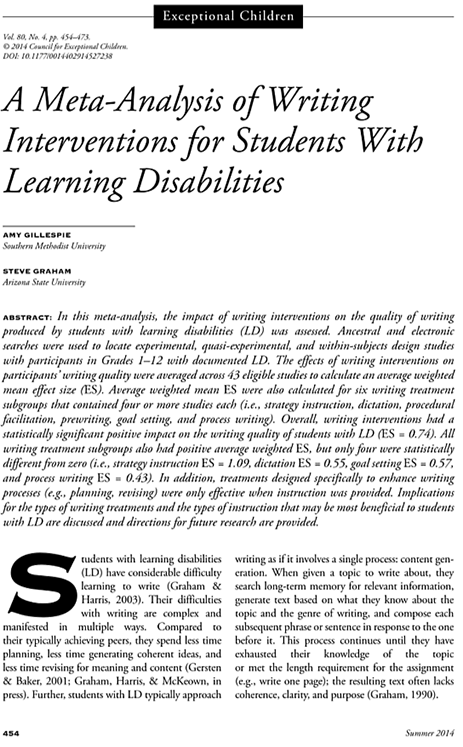
The Writing of Students with LD and a Meta-Analysis of SRSD Writing Intervention Studies: Redux
Graham, Harris, & McKeown, 2013
This chapter synthesizes over 80 studies and delves into the effectiveness of SRSD for students with learning disabilities, highlighting substantial benefits across diverse educational settings. It revisits and updates the...
This chapter synthesizes over 80 studies and delves into the effectiveness of SRSD for students with learning disabilities, highlighting substantial benefits across diverse educational settings. It revisits and updates the topics of writing and learning disabilities (LD) and self-regulated strategy development (SRSD) in writing, previously covered in separate chapters of the first edition. The chapter begins by examining the writing of students with LD, using a new framework that considers strategies, skills, knowledge, and motivation—catalysts of typical writing development not addressed in the previous edition. It then updates the meta-analysis of SRSD, incorporating new studies and employing more advanced analytical procedures to compute effect sizes. Due to space constraints, the focus is narrow, excluding other writing instruction approaches. Finally, the chapter briefly discusses initial and current research on professional development for SRSD.
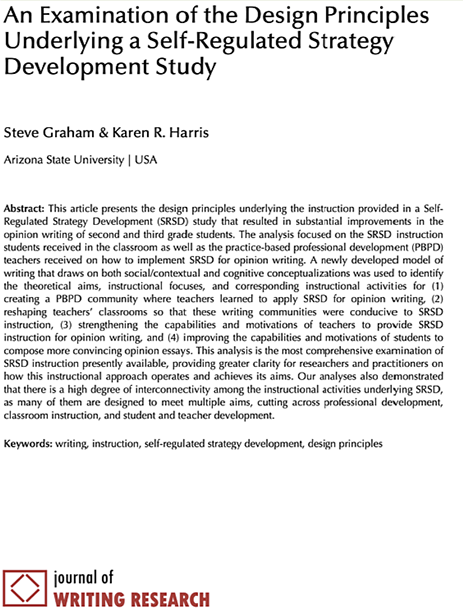
An Examination of the Design Principles Underlying a Self-Regulated Strategy Development Study
2018
This article outlines the design principles behind the Self-Regulated Strategy Development (SRSD) study, which led to significant improvements in the opinion writing of second and third-grade students. The study focused...
This article outlines the design principles behind the Self-Regulated Strategy Development (SRSD) study, which led to significant improvements in the opinion writing of second and third-grade students. The study focused on SRSD instruction provided in the classroom and the practice-based professional development (PBPD) teachers received to implement SRSD for opinion writing. A new writing model, integrating social/contextual and cognitive conceptualizations, was used to identify the theoretical aims, instructional focuses, and activities for (1) creating a PBPD community where teachers learned to apply SRSD for opinion writing, (2) reshaping classrooms to foster writing communities conducive to SRSD instruction, (3) enhancing teachers’ capabilities and motivations to deliver SRSD instruction, and (4) improving students’ abilities and motivations to write convincing opinion essays. This comprehensive analysis offers researchers and practitioners deeper insights into the SRSD instructional approach. It highlights its interconnected instructional activities to meet multiple aims across professional development, classroom instruction, and student and teacher development.
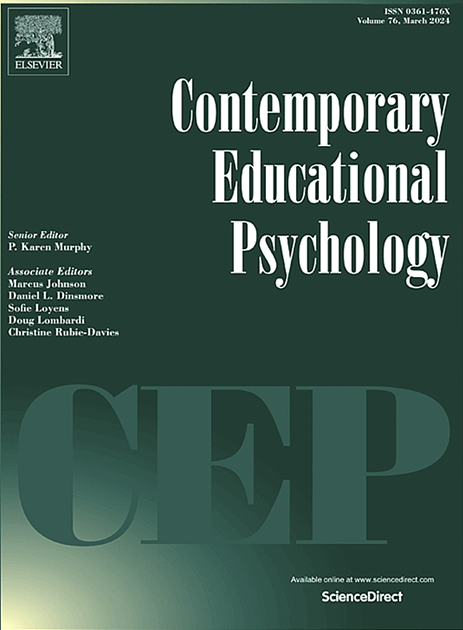
Yes, They Can: Developing Transcription Skills and Oral Language in Tandem with SRSD Instruction on Close Reading of Science Text to Write Informative Essays at Grades 1 and 2
2023
This randomized controlled trial with first- and second-grade students is the first to address whether primary-grade students should develop transcription and oral language abilities before learning to compose. It also...
This randomized controlled trial with first- and second-grade students is the first to address whether primary-grade students should develop transcription and oral language abilities before learning to compose. It also pioneers teaching close reading (using science text aligned to the Next Generation Science Standards) for planning and writing a timed informative essay at these grade levels. The multi-component writing instruction, termed “Self-Regulated Strategy Development (SRSD) Plus,” integrates evidence-based practices for transcription (handwriting and spelling) and oral language skills (vocabulary and sentence structure) with SRSD instruction for close reading to write informative essays. Ninety-three children from a high-poverty school participated (50% boys; mean age = 6.68), with students randomly assigned to either teacher-led SRSD Plus or the business-as-usual writer’s workshop condition. SRSD Plus was implemented in small groups for 45 minutes three times per week for 10 weeks. Outcomes examined included instructional fidelity, spelling, handwriting fluency, vocabulary, sentence proficiency, discourse knowledge, planning, writing quality, structural elements in informative essays, number of words written, transition words, expository text comprehension, and source text. Results showed moderate to large effect sizes in writing outcomes, oral language skills, spelling, and discourse knowledge. The study also examined differential effects due to grade, gender, and race and provided directions for future research.
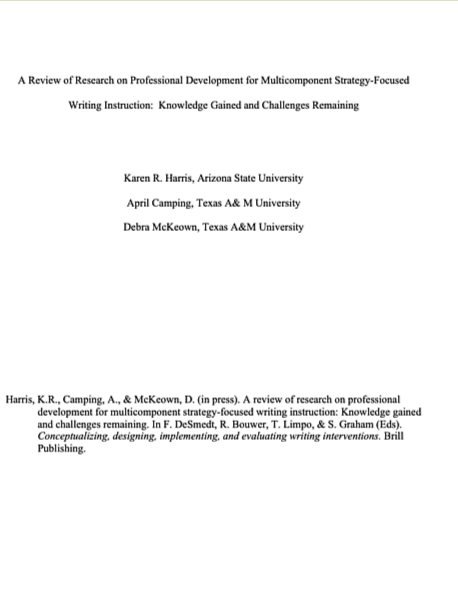
PD for Strategy-Focused Writing Instruction: A Review of Research on Professional Development for Multicomponent Strategy-Focused Writing Instruction: Knowledge Gained and Challenges Remaining
2022
Many students worldwide struggle with writing, a problem exacerbated by inadequate teacher preparation and teachers’ attitudes toward writing instruction. Effective professional development (PD) for teachers is essential to improving students’...
Many students worldwide struggle with writing, a problem exacerbated by inadequate teacher preparation and teachers’ attitudes toward writing instruction. Effective professional development (PD) for teachers is essential to improving students’ writing and reading skills. This study reviews research on PD approaches for multicomponent strategy-focused writing instruction, enhancing writing outcomes for elementary and secondary students in various countries. The review covers 27 studies: 21 on self-regulated strategy development (SRSD), four on cognitive self-regulation instruction (CSRI), and two on Tekster. The studies occurred in the U.S., Portugal, Spain, and the Netherlands. A table and the text details key elements, teacher and student demographics, and outcomes. Findings show a significant increase in PD studies since 2012, with substantial and meaningful improvements in student writing outcomes following teacher PD. The review concludes by identifying challenges and providing recommendations for future research to enhance PD effectiveness in writing instruction further.
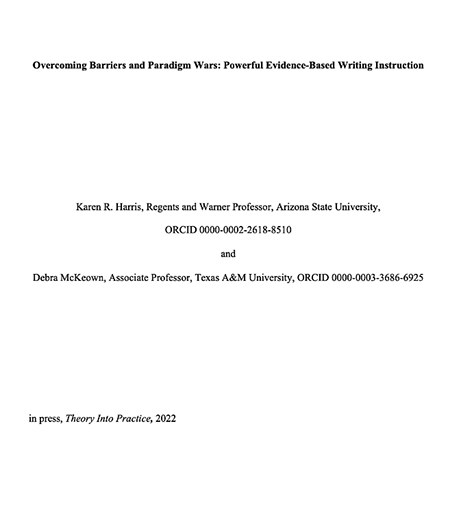
Overcoming Barriers and Paradigm Wars: Powerful Evidence-Based Writing Instruction
2022
“Overcoming Barriers and Paradigm Wars: Powerful Evidence-Based Writing Instruction” by Karen R. Harris and Debra McKeown addresses the critical need for effective writing instruction in K-12 education. This insightful article...
“Overcoming Barriers and Paradigm Wars: Powerful Evidence-Based Writing Instruction” by Karen R. Harris and Debra McKeown addresses the critical need for effective writing instruction in K-12 education. This insightful article delves into the Self-Regulated Strategy Development (SRSD) model, an evidence-based practice that has significantly improved student writing from grades 1-12. Harris and McKeown emphasize integrating SRSD with best practices, including writers’ workshops, to enhance writing instruction. The article highlights the complex nature of writing, noting the many challenges both students and teachers face. It discusses common misconceptions about SRSD, such as the belief that it is only for students with learning disabilities or that it results in formulaic writing. By separating fact from fiction, the authors clearly understand how SRSD can be effectively implemented to improve writing outcomes for all students. Additionally, the article addresses the broader barriers to adopting SRSD, such as paradigm wars in education and the need for better professional development for teachers. By downloading this article, educators will gain valuable insights into a powerful instructional approach that can transform writing education and help students become more proficient and confident writers. This essential read is perfect for teachers, educational leaders, and policymakers committed to enhancing writing instruction and student achievement.
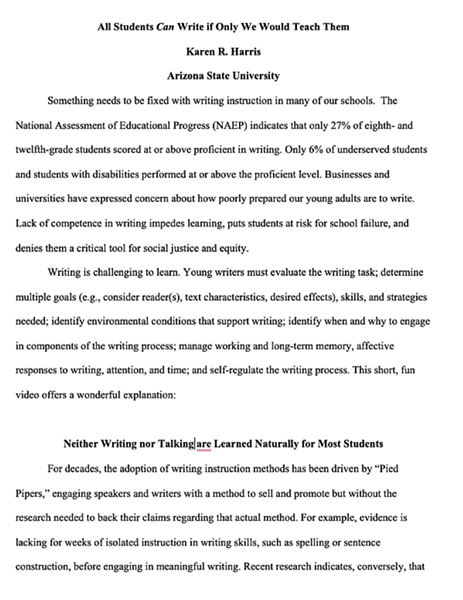
All Students Can Write, if Only We Would Teach Them
Karen R. 2021
In “All Students Can Write, if Only We Would Teach Them,” Karen R. Harris addresses the critical shortcomings in writing instruction that leaves most students, especially underserved and disabled students,...
In “All Students Can Write, if Only We Would Teach Them,” Karen R. Harris addresses the critical shortcomings in writing instruction that leaves most students, especially underserved and disabled students, without proficient writing skills. Citing the National Assessment of Educational Progress (NAEP), Harris reveals that only 27% of eighth- and twelfth-grade students are proficient in writing, with even lower rates for marginalized groups. She critiques ineffective, widely adopted methods and advocates for the Self-Regulated Strategy Development (SRSD) model, a proven, evidence-based approach that significantly enhances student writing across all grade levels. Harris emphasizes that effective writing instruction should integrate SRSD with best practices, moving beyond the false dichotomies and paradigm wars that impede progress. This article provides essential insights for educators and policymakers to revolutionize writing instruction, ensuring all students develop the critical writing skills necessary for academic and professional success.
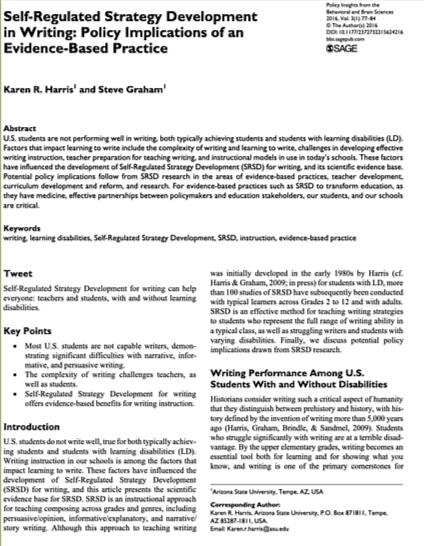
Self-Regulated Strategy Development in Writing: Policy Implications of an Evidence-Based Practice
2016
In their article “Self-Regulated Strategy Development in Writing: Policy Implications of an Evidence-Based Practice,” Karen R. Harris and Steve Graham explore the significant shortcomings in U.S. students’ writing abilities and...
In their article “Self-Regulated Strategy Development in Writing: Policy Implications of an Evidence-Based Practice,” Karen R. Harris and Steve Graham explore the significant shortcomings in U.S. students’ writing abilities and present the Self-Regulated Strategy Development (SRSD) model as a robust solution. This evidence-based instructional approach, initially developed for students with learning disabilities, has been proven effective across diverse student populations from grades 2 to 12. The authors highlight the complex nature of writing and the challenges in teaching it, noting that effective instruction requires integrating multiple theories and evidence-based practices. They discuss the potential for SRSD to transform writing instruction if adopted widely, emphasizing the need for policy changes that support teacher development, curriculum reform, and ongoing research. This comprehensive review underscores the urgency for educational stakeholders to embrace evidence-based practices like SRSD to improve student writing outcomes. Download the full article to learn how SRSD can enhance writing education and meet diverse learning needs.
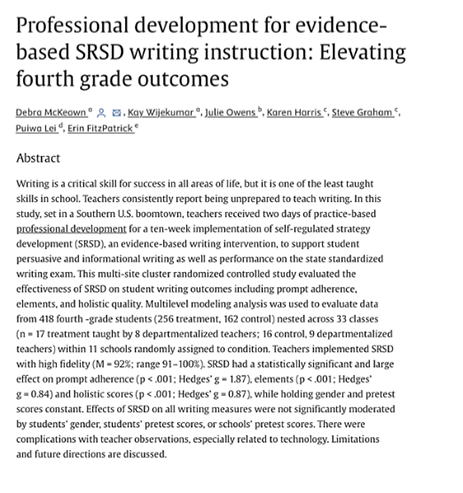
Professional development for evidence-based SRSD writing instruction: Elevating fourth grade outcomes
2023
Writing is a critical skill for success in all areas of life, yet it remains one of the least taught skills in schools, with teachers often needing more preparation to...
Writing is a critical skill for success in all areas of life, yet it remains one of the least taught skills in schools, with teachers often needing more preparation to teach it effectively. This study, conducted in a Southern U.S. boomtown, provided two days of practice-based professional development for teachers to implement Self-Regulated Strategy Development (SRSD), an evidence-based writing intervention, over ten weeks. The study aimed to improve student persuasive and informational writing and performance on state standardized exams. It involved 418 fourth-grade students across 33 classes in 11 schools, using multilevel modeling to evaluate outcomes. Results showed that SRSD significantly improved prompt adherence (p < .001; Hedges’ g = 1.87), writing elements (p < .001; Hedges’ g = 0.84), and holistic quality (p < .001; Hedges’ g = 0.87), with high fidelity of implementation (M = 92%). The effects were consistent regardless of students’ gender or pretest scores. Despite some complications with teacher observations, particularly related to technology, the findings support the effectiveness of SRSD and highlight the need for further research and improved teacher preparation in writing instruction.
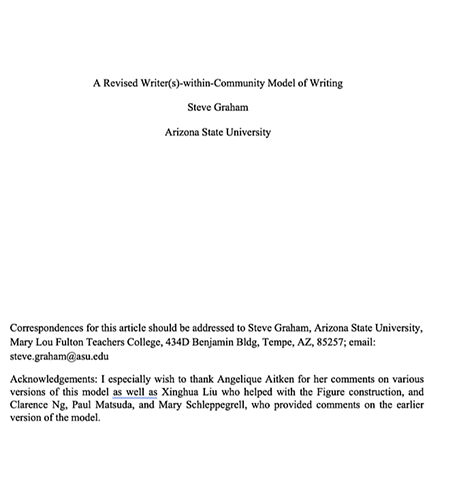
A Revised Writer(s)-Within-Community Model of Writing
2018
In his revised model of the writer(s)-within-community (WWC), Steve Graham conceptualizes writing as a multifaceted social activity deeply rooted in specific writing communities. This updated model synthesizes sociocultural and cognitive...
In his revised model of the writer(s)-within-community (WWC), Steve Graham conceptualizes writing as a multifaceted social activity deeply rooted in specific writing communities. This updated model synthesizes sociocultural and cognitive perspectives, emphasizing that the interplay between community characteristics and individual cognitive abilities shapes writing. Graham outlines that writing communities are defined by their purposes, members, tools, actions, written products, environments, and collective histories, all influenced by broader social, cultural, political, institutional, and historical contexts. He underscores that individual writers bring unique cognitive resources, such as long-term memory, control mechanisms, and production processes, which interact with community factors to shape writing practices. The model identifies modulating factors like emotions, personality traits, and physiological states as crucial to writing processes. Additionally, it posits that writing development results from active participation in writing communities and individual cognitive growth, influenced by various biological and environmental factors. The WWC model offers a comprehensive framework for understanding writing, suggesting that variability within writing communities and individual differences among members are essential to the writing process. Graham’s model provides valuable insights for educators and researchers, proposing that future research should focus on describing, explaining, and predicting writing behaviors within this integrated cognitive-sociocultural framework. Overall, the revised WWC model enriches our understanding of writing as a dynamic and contextually embedded activity, highlighting the need for a holistic approach to studying writing development and practices.
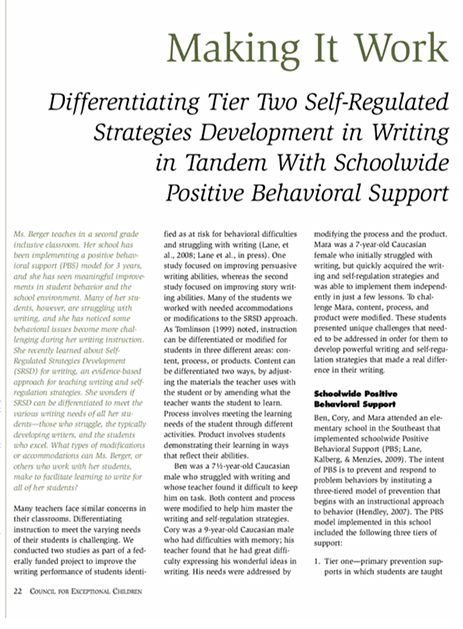
Making it Work: Differentiating Tier Two Writing Instruction with Self-Regulated Strategies Development in Tandem with Schoolwide Positive Behavioral Support for Second Graders
2009
The study “Making it Work: Differentiating Tier Two Writing Instruction with Self-Regulated Strategies Development in Tandem with Schoolwide Positive Behavioral Support for Second Graders” demonstrated significant improvements in students’ writing...
The study “Making it Work: Differentiating Tier Two Writing Instruction with Self-Regulated Strategies Development in Tandem with Schoolwide Positive Behavioral Support for Second Graders” demonstrated significant improvements in students’ writing performance through differentiated SRSD instruction within a PBS framework. Ben’s story elements increased from 0 to an average of 6, with quality scores rising to 4.67. Cory increased from 0 to an average of 5 elements, and his average quality score improved to 1.5. Mara’s essay elements increased from 4 to an average of 8.67, with quality scores improving to 5.33. These results illustrate the positive impact of this combined approach on writing proficiency and self-regulation skills for second graders.
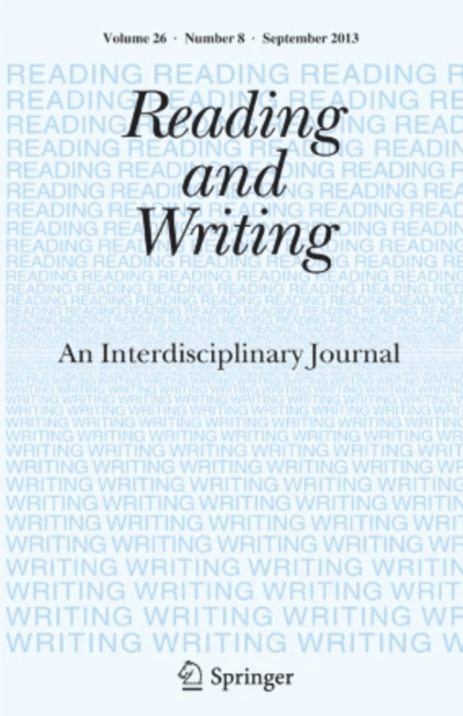
Reading and Writing: An Interdisciplinary Journal
2024
A study on Self-Regulated Strategy Development (SRSD) examined its impact on English writing outcomes, analyzing 43 effect sizes from 22 studies. Results showed that SRSD significantly improved writing quality and...
A study on Self-Regulated Strategy Development (SRSD) examined its impact on English writing outcomes, analyzing 43 effect sizes from 22 studies. Results showed that SRSD significantly improved writing quality and elements, though it had a smaller impact on writing length. Published journal articles reported larger effect sizes than dissertations. This meta-analysis informs practitioners about SRSD’s overall effectiveness and factors influencing its success.
Reading and Writing is a highly cited journal in Education and Educational Psychology that publishes interdisciplinary scientific articles on the processes, acquisition, and loss of reading and writing skills. The journal covers linguistics, neuropsychology, cognitive psychology, speech and hearing science, and education. The journal includes studies on reading, writing, and spelling models, orthography, computer literacy, cross-cultural studies, and developmental and acquired disorders. It features research articles, reviews, theoretical papers, and case studies.
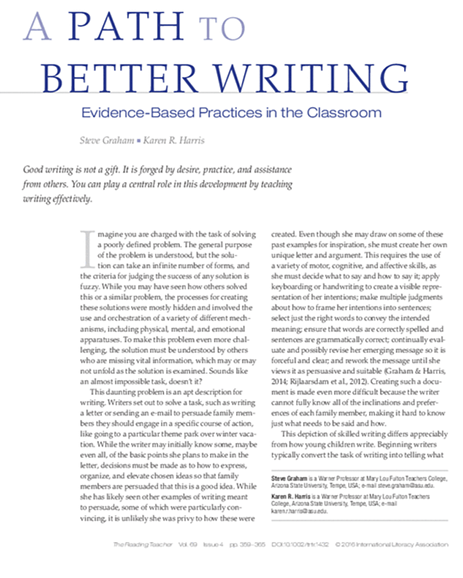
A Path to Better Writing: Evidence-Based Practices in the Classroom
2016
This study explores how effective writing instruction can bridge the gap between novice and skilled writers, focusing on the Self-Regulated Strategy Development (SRSD) model. It examines the impact of SRSD...
This study explores how effective writing instruction can bridge the gap between novice and skilled writers, focusing on the Self-Regulated Strategy Development (SRSD) model. It examines the impact of SRSD on improving opinion writing among second and third-graders, alongside the practice-based professional development (PBPD) provided to teachers for implementing SRSD. The study highlights the importance of creating supportive writing communities in classrooms, enhancing teachers’ capabilities and motivations, and fostering students’ ability to compose persuasive essays. It details the interconnected instructional activities that contribute to the success of SRSD, offering practical guidance for educators. Additionally, the study emphasizes the integration of writing with reading and learning, direct instruction in specific writing skills, and using 21st-century writing tools. By downloading this study, teachers will gain evidence-based strategies to create a motivating writing environment, support students’ writing processes, and enhance their writing competence.
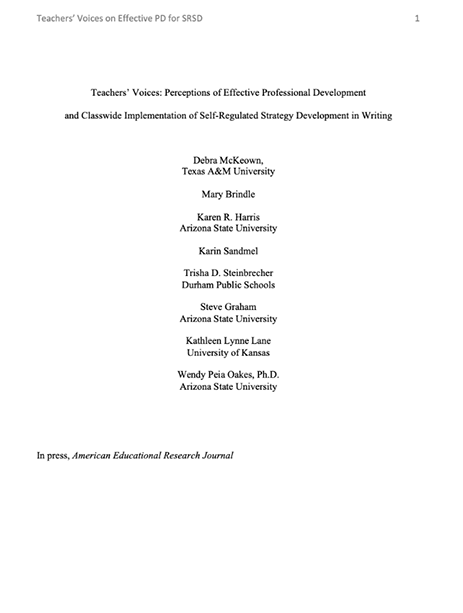
Teachers’ Voices: Perceptions of Effective Professional Development and Classwide Implementation of Self-Regulated Strategy Development in Writing
2019
A qualitative study of a larger mixed-methods study on PD for SRSD in writing found significant outcomes for teachers and students. Despite agreement on essential design elements for professional development...
A qualitative study of a larger mixed-methods study on PD for SRSD in writing found significant outcomes for teachers and students. Despite agreement on essential design elements for professional development (PD), many PD studies have not shown the expected positive outcomes for teachers or students. Therefore, mixed methods studies must explore the conditions and reasons for PD success. This qualitative study, part of a larger mixed methods research on PD for self-regulated strategy development (SRSD) in writing, builds on a randomized controlled trial that showed significant results for teachers and students. Here, 14 Grade 2 and 3 teachers participated in small focus groups discussing their experiences with PD and SRSD, providing insights into effective PD elements. This study highlights the critical components of successful PD and SRSD implementation.
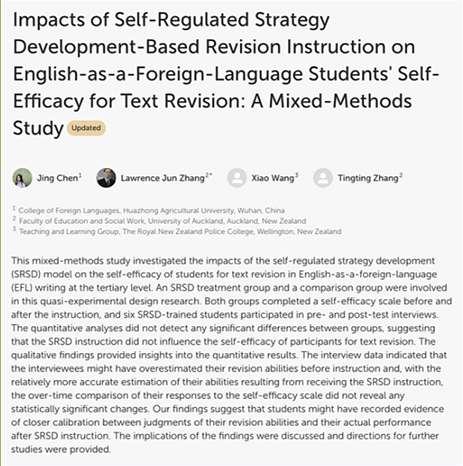
Impacts of Self-Regulated Strategy Development-Based Revision Instruction on English-as-a-Foreign-Language Students' Self-Efficacy for Text Revision: A Mixed-Methods Study
2021
This study explored the effects of the SRSD model on college students’ self-efficacy in text revision within an EFL context. Although definitive evidence of enhanced self-efficacy post-SRSD instruction wasn’t found,...
This study explored the effects of the SRSD model on college students’ self-efficacy in text revision within an EFL context. Although definitive evidence of enhanced self-efficacy post-SRSD instruction wasn’t found, results suggest SRSD might help students make more accurate self-assessments regarding their revision abilities. This is important for EFL instructors, who should monitor students’ self-efficacy and performance to prevent negative impacts from unrealistic self-assessments. Researchers have noted that discrepancies between self-efficacy and actual performance can arise from a lack of task familiarity, leading to overconfidence and insufficient effort allocation. Despite several limitations, such as convenience sampling and non-representative interviewees, the study highlighted potential positive changes in self-efficacy among motivated students. Future research should address these limitations by including a diverse range of participants and extending the duration of SRSD instruction. Examining how task knowledge and other motivational factors influence self-efficacy can provide a better understanding of the SRSD model’s instructional effects. Prior studies have found positive self-efficacy and mastery motivation results, indicating the need for comprehensive examination in future SRSD research.
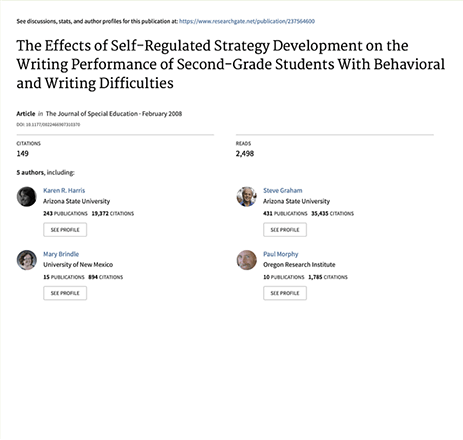
The Effects of Self-Regulated Strategy Development on the Writing Performance of Second-Grade Students With Behavioral and Writing Difficulties
2008
The 2011 study by Lane, Harris, Graham, and others, titled “The Effects of Self-Regulated Strategy Development for Second-Grade Students with Writing and Behavioral Difficulties,” published in the Journal of Research...
The 2011 study by Lane, Harris, Graham, and others, titled “The Effects of Self-Regulated Strategy Development for Second-Grade Students with Writing and Behavioral Difficulties,” published in the Journal of Research on Educational Effectiveness, investigated how SRSD instruction impacts second-grade students with writing and behavioral challenges. This randomized controlled trial involved 44 students within a comprehensive three-tiered prevention model that included behavioral, social, and academic components. Students were randomly assigned to either an experimental group, which received SRSD as a Tier 2 intervention, or a control group with the regular writing program. The experimental group received individual instruction on planning and composing strategies for opinion essays and stories, meeting 3 to 4 times per week for 30-minute sessions over 3 to 12 weeks per genre. The SRSD group improved significantly more in writing quality and composition than the control group, particularly in opinion essays and stories. They also demonstrated increased academic engagement during opinion essay writing in the regular classroom. However, transfer and behavioral effects were limited. The study discusses the implications of these findings.
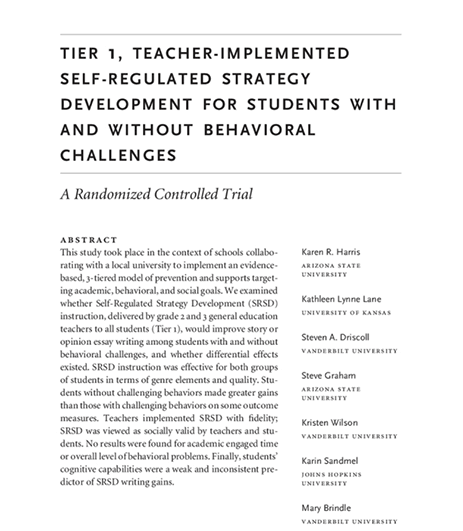
Tier 1, Teacher-Implemented Self-Regulated Strategy Development for Students With and Without Behavioral Challenges
2012
In 2012, Harris and Lane, Driscoll, Graham, and others published a study in the Elementary School Journal titled “Tier 1, Teacher-Implemented Self-Regulated Strategy Development for Students with and Without Behavioral...
In 2012, Harris and Lane, Driscoll, Graham, and others published a study in the Elementary School Journal titled “Tier 1, Teacher-Implemented Self-Regulated Strategy Development for Students with and Without Behavioral Challenges.” This research investigated the implementation of SRSD by grade 2 and 3 teachers in classrooms with diverse students, including those with and without behavioral challenges. The study was conducted in schools collaborating with a local university and was part of an evidence-based, three-tiered prevention model targeting academic, behavioral, and social goals. The study found that SRSD instruction improved all students’ story and opinion essay writing. However, students without behavioral challenges showed greater gains on some measures. Teachers implemented SRSD with high fidelity, which was considered socially valid by both teachers and students. There were no significant results for academic engaged time or overall behavioral problems, and students’ cognitive capabilities were weak and inconsistent predictors of SRSD writing gains.
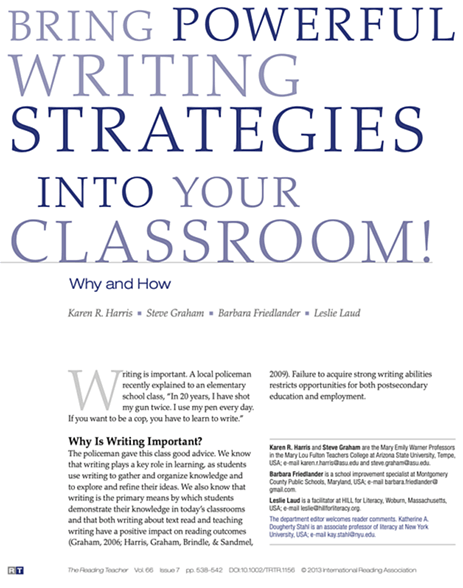
Bring Powerful Writing Strategies Into Your Classroom! Why and How
2013
This study, titled “Bring Powerful Writing Strategies Into Your Classroom! Why and How,” explores the essential role of writing in education and its impact on learning, demonstrating knowledge, and career...
This study, titled “Bring Powerful Writing Strategies Into Your Classroom! Why and How,” explores the essential role of writing in education and its impact on learning, demonstrating knowledge, and career success. The study emphasizes the importance of writing in the new Common Core State Standards, which highlight foundational skills and diverse writing applications. However, as shown by the National Assessment of Educational Progress data, many students struggle with writing. The study advocates for the Self-Regulated Strategy Development (SRSD) approach, which has proven effective in over 80 studies for improving students’ writing skills across various genres. SRSD involves explicit, interactive instruction in writing strategies and self-regulation, conducted in six flexible, recursive stages, with a gradual release of responsibility to students. This approach enhances students’ motivation, self-efficacy, and writing proficiency. The study also underscores the effectiveness of practice-based professional development (PBPD) for teachers, which includes collective participation, addressing student needs, and active learning opportunities. Resources for SRSD, including lesson plans and interactive tutorials, are available online to support teachers in implementing these strategies in their classrooms.
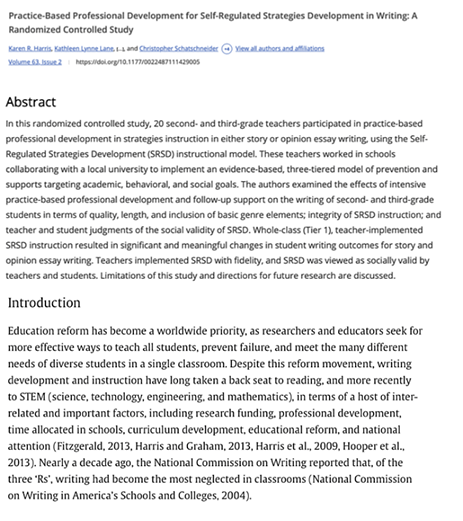
Practice-Based Professional Development for Self-Regulated Strategies Development in Writing: A Randomized Controlled Study
2012
In the 2012 study “Practice-Based Professional Development for Self-Regulated Strategies Development in Writing,” published in the Journal of Teacher Education, Harris and colleagues investigated the impact of practice-based professional development...
In the 2012 study “Practice-Based Professional Development for Self-Regulated Strategies Development in Writing,” published in the Journal of Teacher Education, Harris and colleagues investigated the impact of practice-based professional development for teachers on SRSD in writing. This randomized controlled study involved 20 second and third-grade teachers who received professional development in SRSD instruction for either story or opinion essay writing. The teachers collaborated with a local university to implement an evidence-based, three-tiered model targeting academic, behavioral, and social goals. The study assessed the effects of intensive professional development and follow-up support on student writing quality, length, genre elements, the integrity of SRSD instruction, and the social validity as perceived by teachers and students. The results significantly improved student writing outcomes for story and opinion essays. Teachers implemented SRSD with high fidelity, and teachers and students viewed SRSD as socially valid. The study also discussed its limitations and suggested directions for future research.
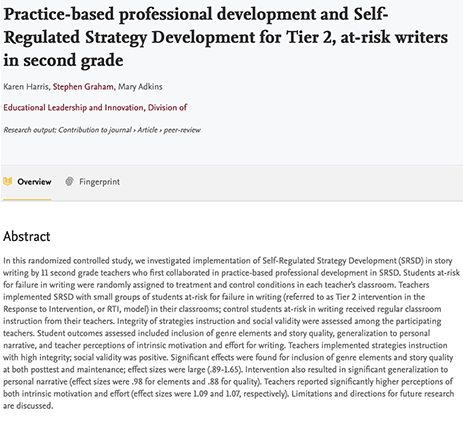
Practice-based Professional Development and Self-Regulated Strategy Development for Tier 2, At-risk Writers in Second Grade
2015
In 2015, Graham, Harris, and Adkins published a study in Contemporary Educational Psychology examining the effects of practice-based professional development on implementing Self-Regulated Strategy Development (SRSD) for at-risk second-grade writers....
In 2015, Graham, Harris, and Adkins published a study in Contemporary Educational Psychology examining the effects of practice-based professional development on implementing Self-Regulated Strategy Development (SRSD) for at-risk second-grade writers. This randomized controlled study involved 11 teachers who participated in professional development for SRSD in story writing. At-risk students were randomly assigned to either treatment or control groups within each teacher’s classroom. The treatment group received SRSD instruction, while the control group received regular classroom instruction. The study assessed the integrity of SRSD implementation and its social validity, along with student outcomes such as genre element inclusion, story quality, generalization to personal narrative, and teacher perceptions of intrinsic motivation and effort. Results showed that teachers implemented SRSD with high integrity and positive social validity. Significant improvements were observed in genre elements and story quality at posttest and maintenance, with large effect sizes (0.89-1.65). The intervention also significantly improved generalization to personal narrative and increased teachers’ perceptions of students’ intrinsic motivation and effort (effect sizes of 1.09 and 1.07, respectively). The study discusses its limitations and suggests directions for future research.
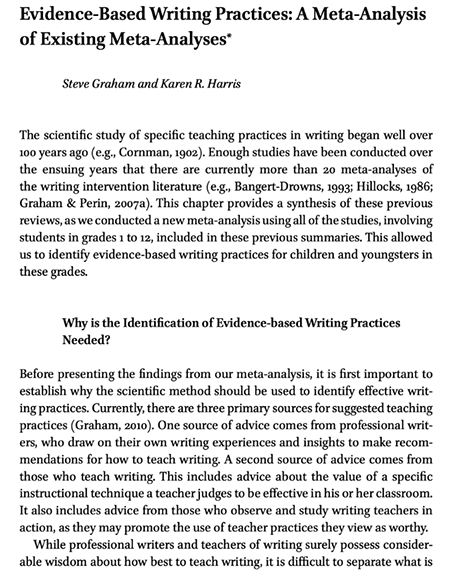
Evidence-Based Writing Practices: A Meta-Analysis of Existing Meta-Analyses
2017
In 2017, Graham and Harris examined existing meta-analyses, reporting a large effect size (ES = 1.59) for Self-Regulated Strategy Development (SRSD). Additionally, Graham, Kiuhara, McKeown, and Harris conducted a comprehensive...
In 2017, Graham and Harris examined existing meta-analyses, reporting a large effect size (ES = 1.59) for Self-Regulated Strategy Development (SRSD). Additionally, Graham, Kiuhara, McKeown, and Harris conducted a comprehensive meta-analysis of writing instruction for elementary students, published in the Journal of Educational Psychology. This analysis provided valuable insights into the effectiveness of various writing instruction methods, including SRSD, for younger students. The scientific study of specific teaching practices in writing began over 100 years ago (e.g., Cornman, 1902), and since then, more than 20 meta-analyses of writing intervention literature have been conducted (e.g., Bangert-Drowns, 1993; Hillocks, 1986; Graham & Perin, 2007a). This chapter synthesizes these previous reviews and includes a new meta-analysis using all studies from these summaries, encompassing students in grades 1 to 12. This comprehensive approach allowed the identification of evidence-based writing practices for children.
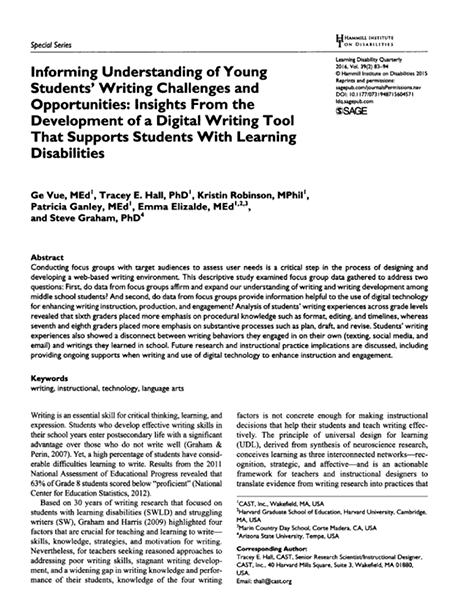
Informing Understanding of Young Students’ Writing Challenges and Opportunities: Insights from the Development of a Digital Writing Tool That Supports Students with Learning Disabilities
2015
Conducting focus groups with target audiences to assess user needs is essential for designing and developing a web-based writing environment. This descriptive study examined focus group data to address two...
Conducting focus groups with target audiences to assess user needs is essential for designing and developing a web-based writing environment. This descriptive study examined focus group data to address two questions: Do focus groups enhance our understanding of writing development among middle school students, and do they provide useful information for using digital technology to improve writing instruction and engagement? Analysis revealed that sixth graders focused more on procedural knowledge like format, editing, and timelines, while seventh and eighth graders emphasized substantive processes such as planning, drafting, and revising. There was a noticeable disconnect between the informal writing students engaged in independently (texting, social media, email) and the formal writing taught in school. The study discusses implications for future research and instructional practice, highlighting the need for ongoing support in writing and the use of digital technology to enhance instruction and engagement. Additionally, Graham has recently been involved in developing and testing digital tools for writing and reading, supported by grants from the Institute of Educational Sciences and the Office of Special Education Programs in the U.S. Department of Education.
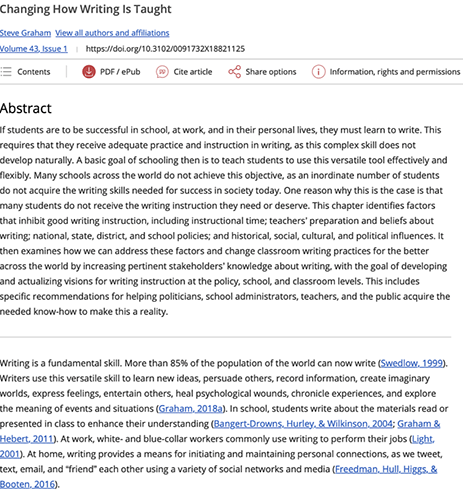
Changing How Writing Is Taught
2019
In this work, Graham emphasizes the necessity of adequate practice and instruction in writing, asserting that this complex skill only develops naturally. He argues that students must learn to write...
In this work, Graham emphasizes the necessity of adequate practice and instruction in writing, asserting that this complex skill only develops naturally. He argues that students must learn to write effectively to succeed in school, work, and personal life. Despite the importance of writing, many schools fail to equip students with the necessary skills, often due to insufficient instruction. Key factors inhibiting good writing instruction include limited instructional time, inadequate teacher preparation, and restrictive policies at various levels. Graham suggests addressing these issues by enhancing stakeholders’ knowledge about writing. He proposes specific recommendations for politicians, school administrators, teachers, and the public to develop and implement effective writing instruction policies, ultimately improving classroom practices globally.
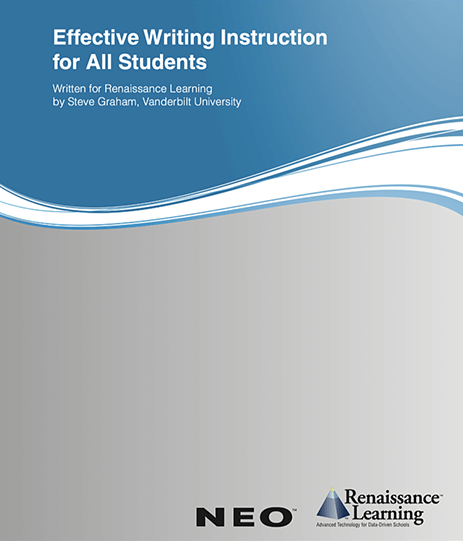
Effective Writing Instruction for All Students
2008
Nearly 60% of children cannot read classroom material, 50% of high school graduates need to prepare for college-level reading and reading remediation costs businesses $3.1 billion annually. To address these...
Nearly 60% of children cannot read classroom material, 50% of high school graduates need to prepare for college-level reading and reading remediation costs businesses $3.1 billion annually. To address these issues, it is crucial to implement effective writing programs using 27 evidence-based practices across all grade levels while continuously monitoring and adjusting their success. Creating a supportive environment where students write daily and engage in all writing processes (planning, drafting, editing, revising, and publishing) is essential. Introducing different genres and modeling the writing process helps students understand and practice various writing styles. Incorporating basic skills instruction and maintaining a balance between writing time and skill development are vital. Gradually adding other practices, such as assessment techniques and motivation strategies, will enhance the writing program. Experienced teachers can integrate these procedures from the start, while less experienced teachers should systematically build them into their instruction.
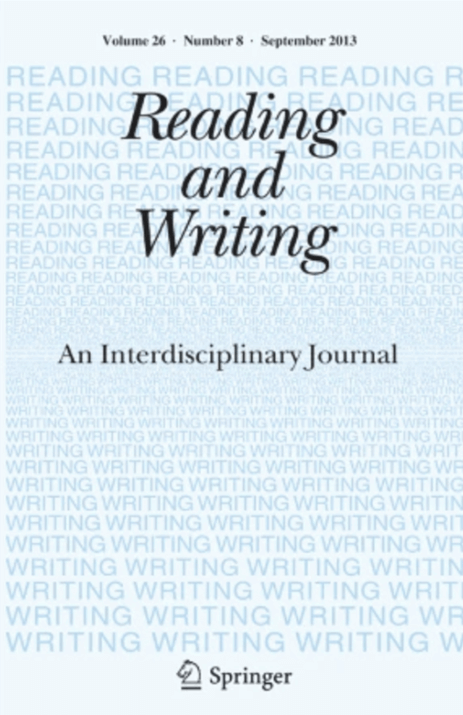
The Effectiveness of Self-Regulated Strategy Development on Improving English Writing: Evidence from the Last Decade
2022
Self-Regulated Strategy Development (SRSD) is a criterion-referenced teaching method that integrates explicit, systematic instruction in writing strategies, knowledge, skills, and self-regulation processes. This study evaluates the overall impact of SRSD...
Self-Regulated Strategy Development (SRSD) is a criterion-referenced teaching method that integrates explicit, systematic instruction in writing strategies, knowledge, skills, and self-regulation processes. This study evaluates the overall impact of SRSD on English writing outcomes, examining moderating factors such as outcome features (writing outcome, genre, measure type), methodological aspects (assignment, intervention duration, quality), learner characteristics (educational level, country), and publication details (type). Analyzing 43 effect sizes from 22 studies over the past decade, results indicate a significant positive effect of SRSD on writing outcomes. The study also found variations in effect sizes based on writing outcome type and publication format, with journal articles showing larger effect sizes than dissertations. This meta-analysis provides valuable insights for educators and program designers on SRSD’s effectiveness in enhancing English writing.
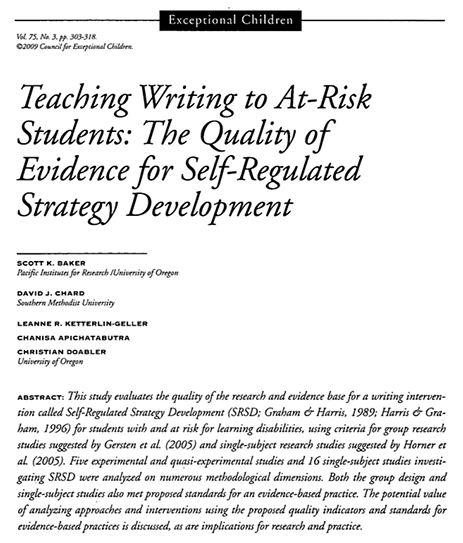
Teaching Writing to At-risk Students: The Quality of Evidence for Self-Regulated Strategy Development
2009
Research on Self-Regulated Strategy Development (SRSD) has received favorable ratings from the National Center on Intensive Interventions, formerly the National Center for Response to Intervention. This recognition underscores SRSD’s effectiveness...
Research on Self-Regulated Strategy Development (SRSD) has received favorable ratings from the National Center on Intensive Interventions, formerly the National Center for Response to Intervention. This recognition underscores SRSD’s effectiveness as an instructional intervention, particularly in providing intensive, personalized support to meet diverse educational needs. The positive evaluation from this reputable source affirms SRSD’s role as a powerful tool for enhancing writing and learning strategies among students requiring targeted instructional approaches. A study titled “Teaching Writing to At-Risk Students: The Quality of Evidence for Self-Regulated Strategy Development” by Baker et al. (2009), published in *Exceptional Children*, evaluates the research quality and evidence base for SRSD. Using criteria from Gersten et al. (2005) for group research studies and Horner et al. (2005) for single-subject research, the study analyzed five experimental and quasi-experimental studies and 16 single-subject studies. Both types of studies met the standards for evidence-based practice, demonstrating SRSD’s effectiveness in improving writing skills among at-risk students. The findings confirm SRSD as an evidence-based practice, highlighting its potential to address the educational needs of at-risk student populations and reinforcing its validity in special education and beyond.
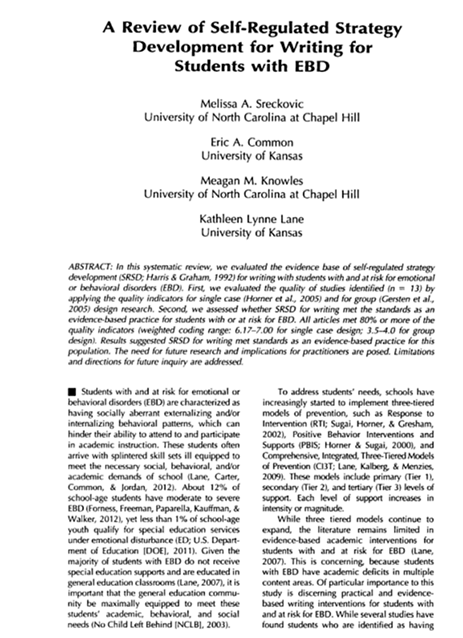
A Review of Self-Regulated Strategy Development for Writing for Students with EBD
2014
This systematic review evaluated the evidence base for Self-Regulated Strategy Development (SRSD; Harris & Graham, 1992) in writing instruction for students with or at risk for emotional or behavioral disorders...
This systematic review evaluated the evidence base for Self-Regulated Strategy Development (SRSD; Harris & Graham, 1992) in writing instruction for students with or at risk for emotional or behavioral disorders (EBD). We first assessed the quality of 13 identified studies using the quality indicators for single-case (Horner et al., 2005) and group design research (Gersten et al., 2005). All studies met 80% or more of the quality indicators, with weighted coding ranges of 6.17-7.00 for single-case designs and 3.5-4.0 for group designs. Our analysis confirmed that SRSD for writing meets the standards as an evidence-based practice for students with or at risk for EBD. We discuss the need for future research and its implications for practitioners and address limitations and directions for future inquiries.
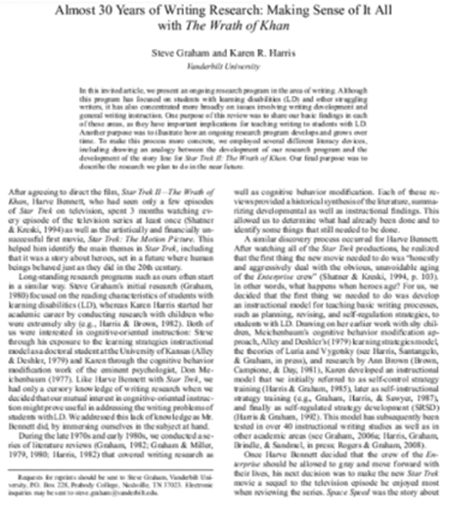
Almost 30 Years of Writing Research: Making Sense of It All with The Wrath of Khan
2009
In the article “Almost 30 Years of Writing Research: Making Sense of It All with The Wrath of Khan,” Steve Graham and Karen R. Harris, published in *Learning Disabilities Research...
In the article “Almost 30 Years of Writing Research: Making Sense of It All with The Wrath of Khan,” Steve Graham and Karen R. Harris, published in *Learning Disabilities Research & Practice*, offer a retrospective analysis of nearly three decades of writing instruction research for students with learning disabilities. Using the metaphor of “The Wrath of Khan,” they explore the complexities and challenges of this research field. The authors review key studies and theoretical advances that have shaped the understanding of writing skill development in students with learning disabilities, emphasizing the effectiveness of the Self-Regulated Strategy Development (SRSD) model. They highlight significant findings, synthesize lessons from extensive research, and propose future directions for practice and study. Advocating for an integrated approach to writing instruction that considers cognitive, behavioral, and emotional components, Graham and Harris provide a comprehensive overview of the evolution of writing research to enhance educational practices supporting students with learning disabilities in becoming proficient writers.
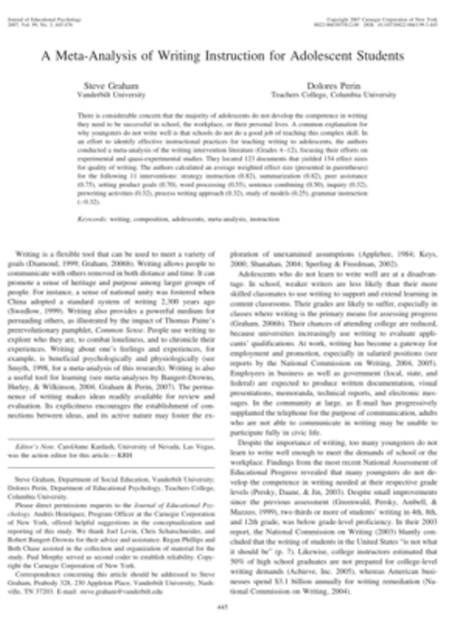
A Meta-Analysis of Writing Instruction for Adolescent Students. Journal of Educational Psychology
Graham, S., & Perin, D. (2007)
In their 2007 study “A Meta-Analysis of Writing Instruction for Adolescent Students,” Steve Graham and Dolores Perin analyze effective writing instruction techniques for middle and high school students. They identify...
In their 2007 study “A Meta-Analysis of Writing Instruction for Adolescent Students,” Steve Graham and Dolores Perin analyze effective writing instruction techniques for middle and high school students. They identify key instructional practices that significantly improve writing skills by pooling results from 123 documents, yielding 154 effect sizes. The meta-analysis highlights several effective interventions, including strategy instruction (effect size 0.82), summarization (0.82), peer assistance (0.75), setting product goals (0.70), and using word processing tools (0.55). Additionally, they find moderate effects for sentence combining (0.50), inquiry (0.32), prewriting activities (0.32), and the process writing approach (0.32) while noting that grammar instruction has a negative effect (-0.32). Their findings underscore the importance of explicit writing strategies, integrating writing with reading, and using process writing approaches. This comprehensive analysis supports educational policies and teaching practices by providing evidence-based recommendations to enhance adolescent students’ writing competencies, which are crucial for their academic and future career success.
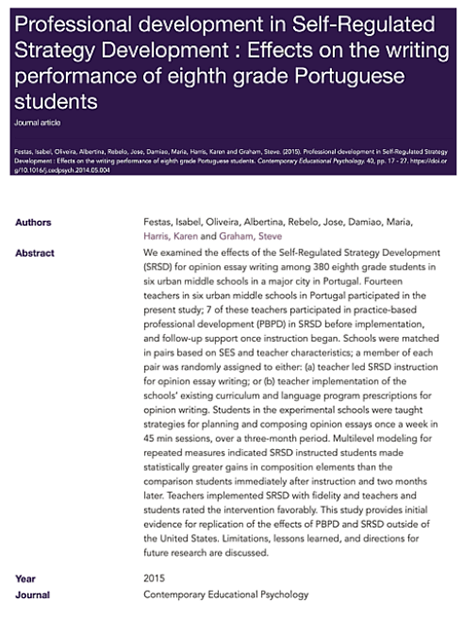
Professional Development in Self-Regulated Strategy Development: Effects on the Writing Performance of Eighth Grade Portuguese Students
2014
We examined the effects of Self-Regulated Strategy Development (SRSD) on opinion essay writing among 380 eighth-grade students in six urban middle schools in a major city in Portugal. Fourteen teachers...
We examined the effects of Self-Regulated Strategy Development (SRSD) on opinion essay writing among 380 eighth-grade students in six urban middle schools in a major city in Portugal. Fourteen teachers participated in the study; seven received practice-based professional development (PBPD) in SRSD before implementation and follow-up support once instruction began. Schools were matched in pairs based on socioeconomic status (SES) and teacher characteristics; one school from each pair was randomly assigned to either teacher-led SRSD instruction for opinion essay writing or the existing curriculum and language program prescriptions for opinion writing. Students in the experimental group were taught strategies for planning and composing opinion essays once a week in 45-minute sessions over three months. Multilevel modeling for repeated measures indicated that students instructed in SRSD made significantly greater gains in composition elements than comparison students immediately after instruction and two months later. Teachers implemented SRSD with high fidelity, and teachers and students rated the intervention favorably. This study provides initial evidence for replicating PBPD and SRSD effects outside the United States. Limitations, lessons learned, and future research directions are discussed.
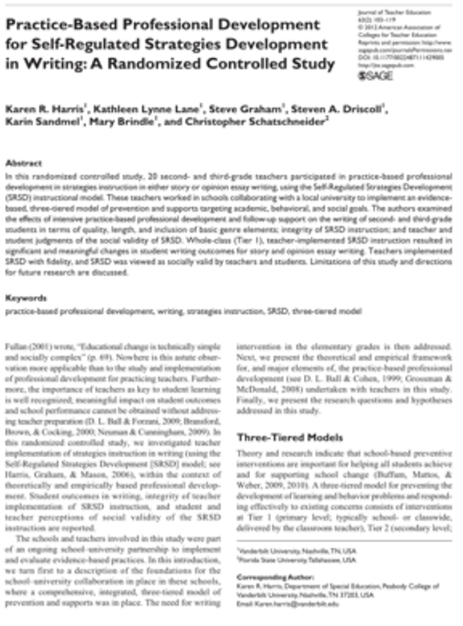
Practice-based Professional Development for Self-Regulated Strategies Development in Writing: A Randomized Controlled Study
Harris, K.R., Lane, K.L., Graham, S., Driscoll, S., Sandmel, K., Brindle, M., & Schatschneider, C. 2012
The 2012 study “Practice-based Professional Development for Self-Regulated Strategies Development in Writing,” conducted by Harris et al. and published in the Journal of Teacher Education, evaluates the effectiveness of a...
The 2012 study “Practice-based Professional Development for Self-Regulated Strategies Development in Writing,” conducted by Harris et al. and published in the Journal of Teacher Education, evaluates the effectiveness of a practice-based professional development (PBPD) program for teachers in implementing Self-Regulated Strategy Development (SRSD) in writing instruction. This randomized controlled trial involved 20 second and third-grade teachers receiving intensive SRSD training. The results showed that teachers participating in the PBPD program significantly improved their instructional practices, enhancing their students’ writing skills. The study underscores the importance of well-structured professional development in equipping teachers with effective writing instruction strategies through the SRSD approach, highlighting the direct benefits of such training on student outcomes.
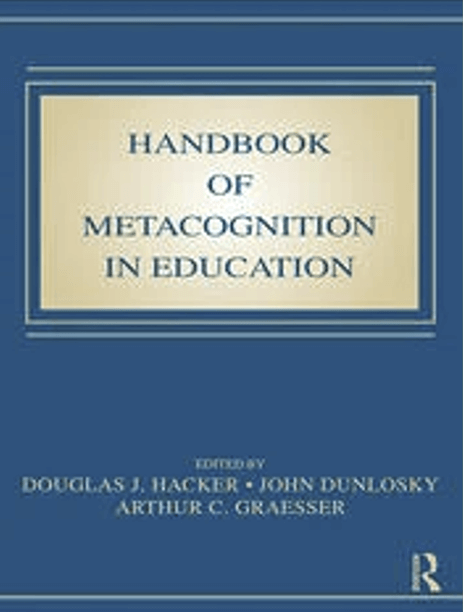
Metacognition and Children's Writing
2009
The chapter “Metacognition and Children’s Writing” by Harris, Graham, Brindle, and Sandmel, in the “Handbook of Metacognition in Education,” examines the crucial role of metacognition in children’s writing. It includes...
The chapter “Metacognition and Children’s Writing” by Harris, Graham, Brindle, and Sandmel, in the “Handbook of Metacognition in Education,” examines the crucial role of metacognition in children’s writing. It includes an updated meta-analysis of Self-Regulated Strategy Development (SRSD) research, demonstrating SRSD’s effectiveness in enhancing writing skills through metacognitive practices. The authors explain that metacognitive skills—such as planning, monitoring, and evaluating one’s writing—are vital for improving students’ writing abilities. They emphasize explicitly teaching these skills to help students manage and enhance their writing processes and outcomes. The chapter aims to provide valuable insights for researchers and practitioners, highlighting that strategies instruction, which addresses multiple metacognitive components, has had the most substantial impact on students’ writing performance. The authors present a comprehensive overview of writing research progress and the role of metacognition, illustrating how writing abilities can be developed through strategies instruction, the most extensively researched and impactful approach.
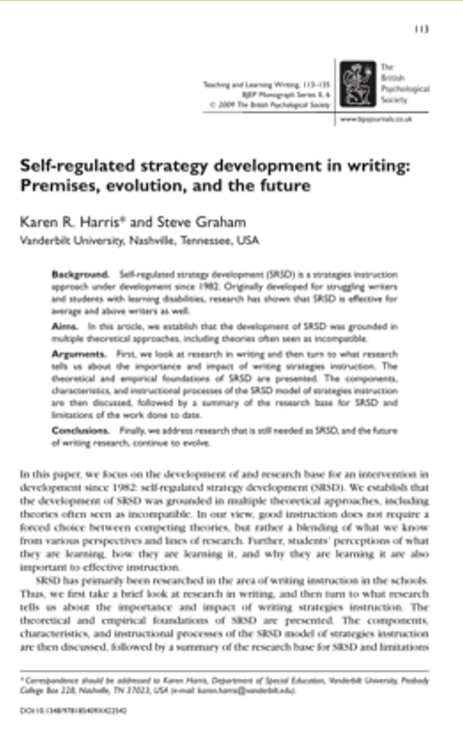
Self-Regulated Strategy Development in Writing: Premises, Evolution, and the Future
Harris, K.R., & Graham, S. (2008)
In “Self-Regulated Strategy Development in Writing: Premises, Evolution, and the Future,” Karen R. Harris and Steve Graham thoroughly examine the Self-Regulated Strategy Development (SRSD) model for writing instruction. They explore...
In “Self-Regulated Strategy Development in Writing: Premises, Evolution, and the Future,” Karen R. Harris and Steve Graham thoroughly examine the Self-Regulated Strategy Development (SRSD) model for writing instruction. They explore SRSD’s theoretical foundations, development over the years, and its impact on teaching practices. The monograph outlines SRSD’s core components, which integrate the teaching of writing strategies, self-regulation skills, and motivational beliefs about writing and oneself as a writer. The authors also discuss future directions for SRSD, highlighting the need for ongoing research and adaptation to address the diverse needs of students. Initially developed in 1982 for struggling writers and students with learning disabilities, SRSD has proven effective for all levels of writers. Harris and Graham establish that SRSD is grounded in multiple theoretical approaches, including those often incompatible. They review research on writing and the impact of writing strategies instruction, present the theoretical and empirical foundations of SRSD, and discuss its components, characteristics, and instructional processes. The monograph concludes with a summary of the SRSD research base, its limitations, and the need for future research to continue evolving SRSD and writing instruction. This work is valuable for educators seeking effective, evidence-based strategies to improve writing education and student engagement.
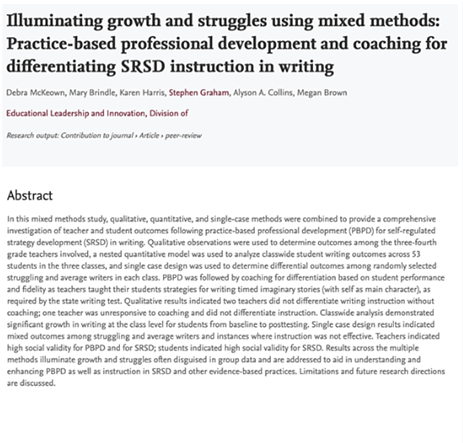
Illuminating growth and struggles using mixed methods: Practice-based professional development and coaching for differentiating SRSD instruction in writing
2016
This mixed methods study combined qualitative, quantitative, and single-case methods to comprehensively investigate teacher and student outcomes following practice-based professional development (PBPD) for self-regulated strategy development (SRSD) in writing. Qualitative...
This mixed methods study combined qualitative, quantitative, and single-case methods to comprehensively investigate teacher and student outcomes following practice-based professional development (PBPD) for self-regulated strategy development (SRSD) in writing. Qualitative observations assessed outcomes among three fourth-grade teachers, while a nested quantitative model analyzed writing outcomes for 53 students across their classes. Additionally, a single-case design examined differential outcomes among randomly selected struggling and average writers. PBPD was followed by coaching for differentiation based on student performance and fidelity as teachers instructed their students on writing timed imaginary stories (with self as the main character) for the state writing test. Qualitative results indicated that two teachers needed to differentiate writing instruction with coaching, and one teacher needed to be more responsive to coaching. Class-wide analysis showed significant growth in student writing from baseline to post-testing. Single-case results indicated mixed outcomes among struggling and average writers, highlighting instances where instruction was ineffective. Both teachers and students rated PBPD and SRSD highly regarding social validity. The study’s findings reveal growth and challenges often hidden in group data, offering insights to enhance PBPD and SRSD instruction. Limitations and future research directions are discussed.
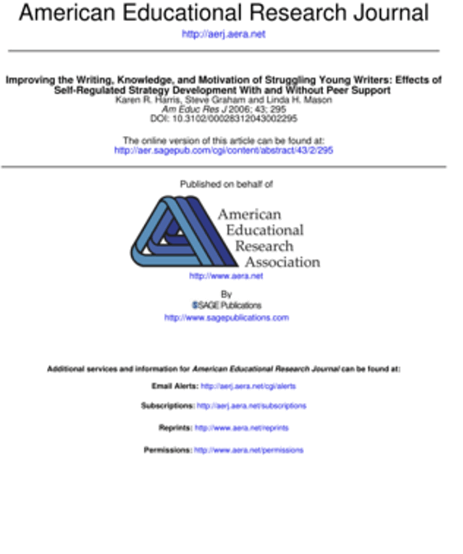
Improving the Writing Performance, Knowledge, and Motivation of Struggling Writers in Second Grade: The Effects of Self-Regulated Strategy Development
Harris, K. R., Graham, S., & Mason, L. H. 2006
In the study “Improving the Writing Performance, Knowledge, and Motivation of Struggling Writers in Second Grade: The Effects of Self-Regulated Strategy Development,” Harris, Graham, and Mason explore the impact of...
In the study “Improving the Writing Performance, Knowledge, and Motivation of Struggling Writers in Second Grade: The Effects of Self-Regulated Strategy Development,” Harris, Graham, and Mason explore the impact of the Self-Regulated Strategy Development (SRSD) approach on young struggling writers. Their research demonstrates that SRSD significantly enhances second graders’ writing abilities, knowledge, and motivation. This intervention teaches students specific writing strategies and self-regulation techniques such as goal setting, self-assessment, and self-reinforcement. The study shows notable improvements in both the quality and quantity of students’ writing, indicating that SRSD effectively supports struggling young writers by addressing the cognitive and motivational aspects of writing. Additionally, SRSD-instructed students outperformed those in the Writers’ Workshop condition in knowledge and performance across instructed genres (story and persuasive writing) and uninstructed genres (personal narrative and informative writing). Including a peer support component further enhanced students’ performance, facilitating maintenance and generalization of writing skills.
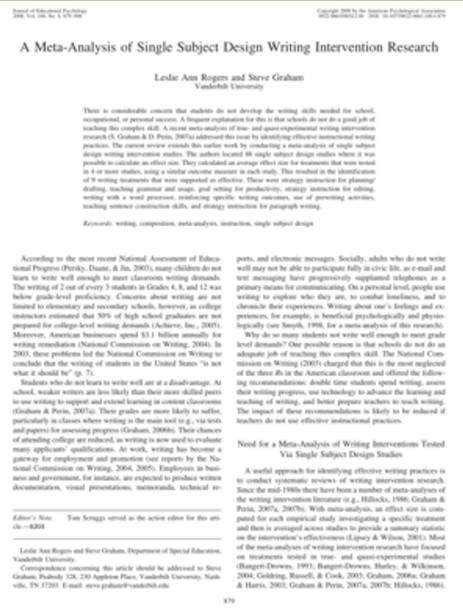
A Meta-Analysis of Single Subject Design Writing Intervention Research
Rogers, L., & Graham, S. (2008)
This meta-analysis by Rogers and Graham reviews single-subject design studies on the effectiveness of writing interventions. By aggregating results from various studies, the analysis determines the impact of different intervention...
This meta-analysis by Rogers and Graham reviews single-subject design studies on the effectiveness of writing interventions. By aggregating results from various studies, the analysis determines the impact of different intervention strategies on students’ writing skills. The study underscores the substantial benefits of targeted, systematically applied, and measured writing interventions, highlighting significant improvements in student writing outcomes. This meta-analysis is a valuable resource for educators and researchers seeking evidence-based practices for teaching writing. It addresses the widespread concern that students often lack the writing skills necessary for success in school, work, and personal life, a problem frequently attributed to inadequate teaching methods. Building on a previous meta-analysis by Graham and Perin (2007a) that identified effective instructional writing practices, this review extends the work by analyzing 88 single-subject design studies where effect sizes could be calculated. The authors identified nine effective writing treatments tested in four or more studies using similar outcome measures: strategy instruction for planning/drafting, teaching grammar and usage, goal setting for productivity, strategy instruction for editing, writing with a word processor, reinforcing specific writing outcomes, prewriting activities, teaching sentence construction skills, and strategy instruction for paragraph writing.

